Paul van Yperen's Blog, page 387
April 1, 2015
Phyllis Dare
English singer and actress Phyllis Dare (1890-1975) was famous for her performances in Edwardian musical comedy and other musical theatre in the first half of the 20th century. She appeared occasionally in films and was one of the leading Picture Postcard beauties of the Belle Epoque.
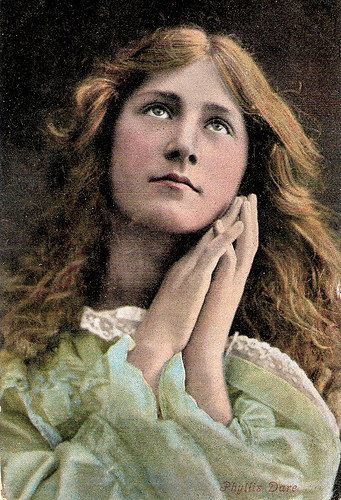
British postcard in the Valentine's Series. Photo: Foulsham & Banfield.
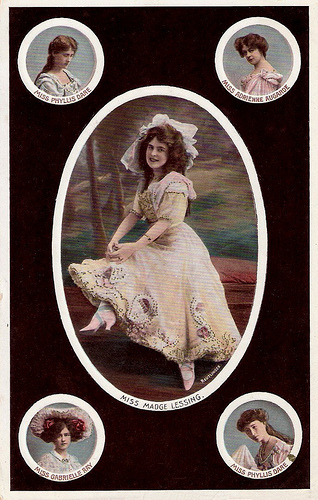
British postcard by H. Vertigen & Co., London, Series no. 6204. In the centre: Madge Lessing. From left under with the clock: Gabrielle Ray, Phyllis Dare, Adrienne Augarde and again Phyllis Dare.
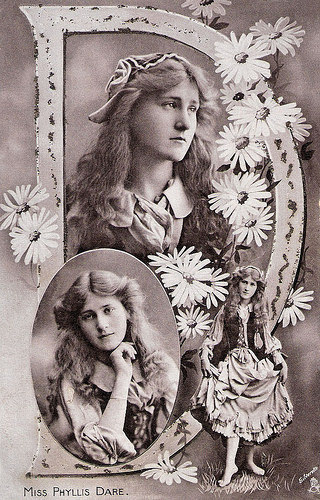
British postcard by Tuck's in the Silverette series, no. P 318.
Leading Picture Postcard Beauties
Phyllis Dare was born Phyllis Constance Haddie Dones in Chelsea, London, in 1890. Her father, Arthur Albert Dones, was a divorce clerk, and her mother was Harriette Amelia Wheeler. Dare was the youngest of three children. Her sister, Zena , three and a half years her senior, also became a well-known musical comedy actress. They had a brother named Jack.
Phyllis first performed on stage at the age of nine, in the Christmas pantomime Babes in the Wood (1899) at the Coronet Theatre in London. Her sister Zena was also cast in this production, and they both adopted the surname of Dare. Both soon became leading Picture Postcard Beauties at the turn of last century.
Phyllis appeared as Little Christina in Ib and Little Christina (1900) at the Prince of Wales's Theatre. She played Mab in the Seymour Hicks musical Bluebell in Fairyland (1901), featuring Hicks himself as Dicky and his actress wife Ellaline Terris as Bluebell.
At the age of 15, she took over the starring role of Angela in The Catch of the Season (1905). She travelled to a convent in the Belgian Ardennes to continue her studies. A rumour circulated that her sudden departure was a result of a pregnancy. In any event, she returned to London with her father in haste in 1906. On short notice she had to take over the title role of Julia Chaldicott, in Leslie Stuart's The Belle of Mayfair when American star Edna May left the cast. Just 16 years old, the role established her as a major performer in London.
In 1909, Dare created the role of Eileen Cavanagh in the hit musical The Arcadians, which played for 809 performances, and Dare stayed for the entire run. The musical marked the beginning of Dare's association with producer George Edwardes, and she went on to star in several more of his productions in the next three years, including The Girl in the Train (1910), Peggy (1911), The Quaker Girl in Paris (1911) and The Sunshine Girl (1912–13). In 1913 she joined the cast of The Dancing Mistress.
Occasionally, she appeared in films. During the 1910s, she starred in the Hepworth production The Argentine Tango and Other Dances (1913) and Dr. Wake's Patient (Fred Paul, 1916). In the first, she danced two drawing-room dances with George Grossmith: the Bunny Hug and the Spanish Tango.
Dare began to develop a relationship with the composer Paul Rubens. He had written the music for The Sunshine Girl, and they became acquainted. He would write the music for her next series of shows, including The Girl from Utah at the Adelphi (1913), Miss Hook of Holland (1914) and Tina (1915). He also dedicated his most famous song, ‘I Love the Moon’ to her. During the run of Tina, Dare became engaged to Rubens. Their engagement ended when Rubens became very ill with consumption. He died in 1917 at the age of 41.
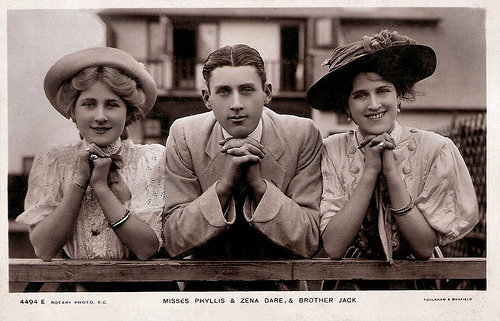
Phyllis, Jack and Zena Dare . British postcard by Rotary Photo, no. 4494 E. Photo: Foulsham & Banfield.
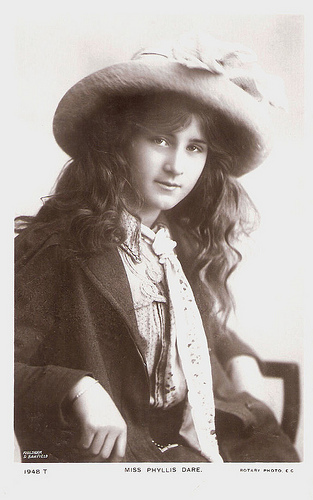
British postcard by Rotary Photo in the Rotary Photographic Series, no. 1948 T. Photo: Foulsham & Banfield.
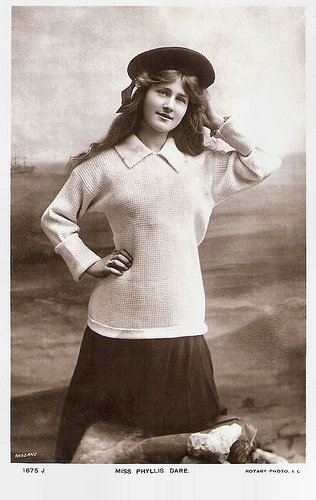
British postcard by Rotary Photo in the Rotary Photographic Series, no. 1875 J. Photo: Bassano. Sent by mail in 1913.
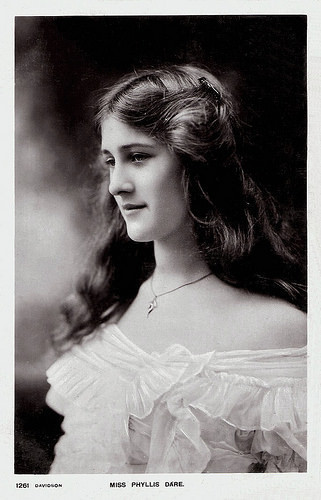
British postcard by Davidson Bros. in the Glossyphoto Series, no. 1261.
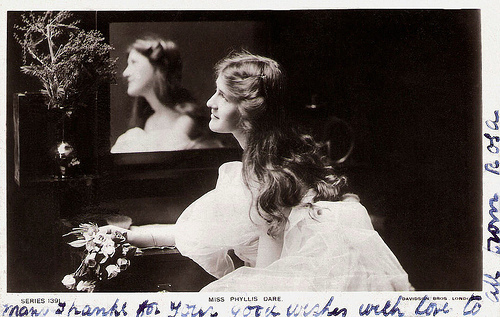
British postcard by Davidson Bros. in the Glossyphoto series, no. 1391. Sent by mail in 1908.
Moving with the time
Phyllis Dare continued to star in successful stage productions throughout the 1920s, such as in The Lady of the Rose (1922) and The Street Singer (1924). As fashions changed, she moved with the time.
Later at nearly 40, Dare turned to straight theatre plays. These included Aren't We All (1929), Words and Music (1932) and The Fugitives (1936).
She also appeared in a number of films, including the American drama The Common Law (George Archainbaud, 1923), the classic British crime film Crime on the Hill (Bernard Vorhaus, 1933), the drama Debt of Honour (Norman Walker, 1936) starring Leslie Banks, the drama Marigold (Thomas Bentley, 1938) and the comedy Gildersleeve on Broadway (Gordon Douglas, 1943).
In 1940, for the first time in over four decades, Phyllis and Zena Dare shared the stage, in a tour of Ivor Novello ’s Full House. In 1941–42, she was Juliet Maddock in Other People's Houses, and in 1946 she played the Marchioness of Mereston in Lady Frederick.
In 1949, Dare opened as Marta the mistress in Ivor Novello 's musical, King's Rhapsody, again with her sister Zena. Nearly eighteen months later Novello died while the play was still running, and at the end of seven more months, in October 1951, it closed. It was Dare's last theatrical endeavour.
At the age of 61, she retired to Brighton in 1951. In 1975, Phyllis Dare died in Brighton at the age of 84. Her sister Zena had died only six weeks earlier.
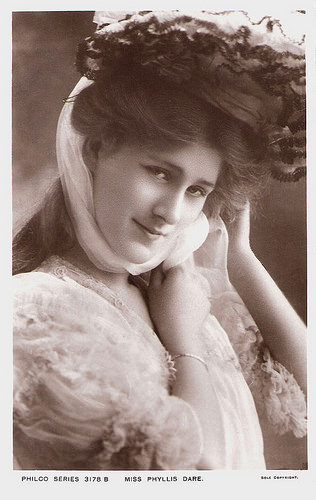
British postcard by in the Philco Series, no. 3178 B.
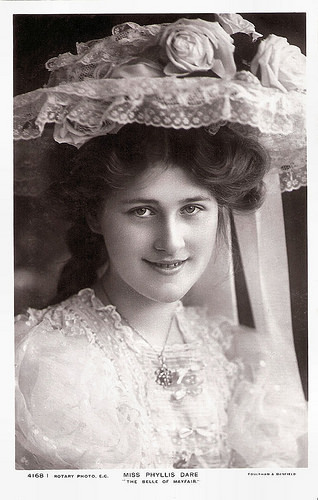
British postcard by Rotary, no. 4168 I. Photo: Foulsham & Banfield. Publicity still for the stage play The Belle of Mayfair (1906).
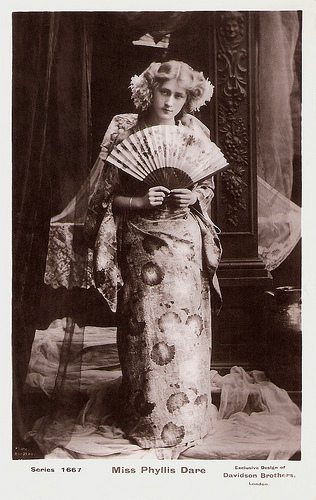
British postcard by Davidson Bros. in the Real Photographic Series, no. 1667.
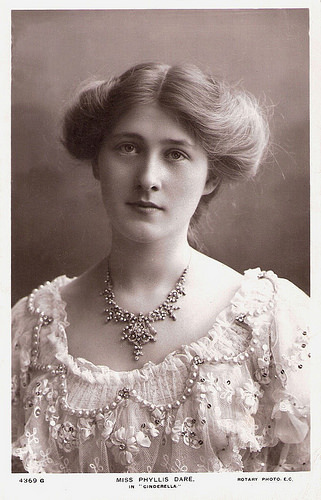
British postcard by Rotary, no. 4369 G. Photo: publicity still for the stage pantomime Cinderella (1907).
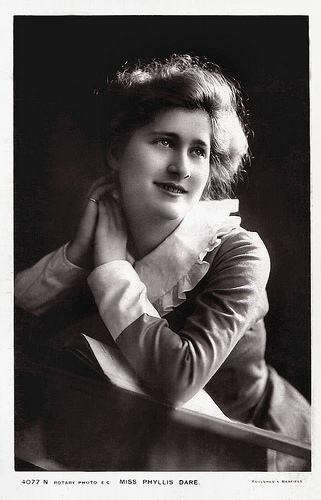
British postcard by Rotary Photo in the Rotary Photographic Series, no. 4077 N. Photo: Foulsham & Banfield.
Sources: Alan Courtney (Stage Beauty), Thomas Staedeli (Cyranos), National Portrait Gallery, Wikipedia and .

British postcard in the Valentine's Series. Photo: Foulsham & Banfield.

British postcard by H. Vertigen & Co., London, Series no. 6204. In the centre: Madge Lessing. From left under with the clock: Gabrielle Ray, Phyllis Dare, Adrienne Augarde and again Phyllis Dare.

British postcard by Tuck's in the Silverette series, no. P 318.
Leading Picture Postcard Beauties
Phyllis Dare was born Phyllis Constance Haddie Dones in Chelsea, London, in 1890. Her father, Arthur Albert Dones, was a divorce clerk, and her mother was Harriette Amelia Wheeler. Dare was the youngest of three children. Her sister, Zena , three and a half years her senior, also became a well-known musical comedy actress. They had a brother named Jack.
Phyllis first performed on stage at the age of nine, in the Christmas pantomime Babes in the Wood (1899) at the Coronet Theatre in London. Her sister Zena was also cast in this production, and they both adopted the surname of Dare. Both soon became leading Picture Postcard Beauties at the turn of last century.
Phyllis appeared as Little Christina in Ib and Little Christina (1900) at the Prince of Wales's Theatre. She played Mab in the Seymour Hicks musical Bluebell in Fairyland (1901), featuring Hicks himself as Dicky and his actress wife Ellaline Terris as Bluebell.
At the age of 15, she took over the starring role of Angela in The Catch of the Season (1905). She travelled to a convent in the Belgian Ardennes to continue her studies. A rumour circulated that her sudden departure was a result of a pregnancy. In any event, she returned to London with her father in haste in 1906. On short notice she had to take over the title role of Julia Chaldicott, in Leslie Stuart's The Belle of Mayfair when American star Edna May left the cast. Just 16 years old, the role established her as a major performer in London.
In 1909, Dare created the role of Eileen Cavanagh in the hit musical The Arcadians, which played for 809 performances, and Dare stayed for the entire run. The musical marked the beginning of Dare's association with producer George Edwardes, and she went on to star in several more of his productions in the next three years, including The Girl in the Train (1910), Peggy (1911), The Quaker Girl in Paris (1911) and The Sunshine Girl (1912–13). In 1913 she joined the cast of The Dancing Mistress.
Occasionally, she appeared in films. During the 1910s, she starred in the Hepworth production The Argentine Tango and Other Dances (1913) and Dr. Wake's Patient (Fred Paul, 1916). In the first, she danced two drawing-room dances with George Grossmith: the Bunny Hug and the Spanish Tango.
Dare began to develop a relationship with the composer Paul Rubens. He had written the music for The Sunshine Girl, and they became acquainted. He would write the music for her next series of shows, including The Girl from Utah at the Adelphi (1913), Miss Hook of Holland (1914) and Tina (1915). He also dedicated his most famous song, ‘I Love the Moon’ to her. During the run of Tina, Dare became engaged to Rubens. Their engagement ended when Rubens became very ill with consumption. He died in 1917 at the age of 41.

Phyllis, Jack and Zena Dare . British postcard by Rotary Photo, no. 4494 E. Photo: Foulsham & Banfield.

British postcard by Rotary Photo in the Rotary Photographic Series, no. 1948 T. Photo: Foulsham & Banfield.

British postcard by Rotary Photo in the Rotary Photographic Series, no. 1875 J. Photo: Bassano. Sent by mail in 1913.

British postcard by Davidson Bros. in the Glossyphoto Series, no. 1261.

British postcard by Davidson Bros. in the Glossyphoto series, no. 1391. Sent by mail in 1908.
Moving with the time
Phyllis Dare continued to star in successful stage productions throughout the 1920s, such as in The Lady of the Rose (1922) and The Street Singer (1924). As fashions changed, she moved with the time.
Later at nearly 40, Dare turned to straight theatre plays. These included Aren't We All (1929), Words and Music (1932) and The Fugitives (1936).
She also appeared in a number of films, including the American drama The Common Law (George Archainbaud, 1923), the classic British crime film Crime on the Hill (Bernard Vorhaus, 1933), the drama Debt of Honour (Norman Walker, 1936) starring Leslie Banks, the drama Marigold (Thomas Bentley, 1938) and the comedy Gildersleeve on Broadway (Gordon Douglas, 1943).
In 1940, for the first time in over four decades, Phyllis and Zena Dare shared the stage, in a tour of Ivor Novello ’s Full House. In 1941–42, she was Juliet Maddock in Other People's Houses, and in 1946 she played the Marchioness of Mereston in Lady Frederick.
In 1949, Dare opened as Marta the mistress in Ivor Novello 's musical, King's Rhapsody, again with her sister Zena. Nearly eighteen months later Novello died while the play was still running, and at the end of seven more months, in October 1951, it closed. It was Dare's last theatrical endeavour.
At the age of 61, she retired to Brighton in 1951. In 1975, Phyllis Dare died in Brighton at the age of 84. Her sister Zena had died only six weeks earlier.

British postcard by in the Philco Series, no. 3178 B.

British postcard by Rotary, no. 4168 I. Photo: Foulsham & Banfield. Publicity still for the stage play The Belle of Mayfair (1906).

British postcard by Davidson Bros. in the Real Photographic Series, no. 1667.

British postcard by Rotary, no. 4369 G. Photo: publicity still for the stage pantomime Cinderella (1907).

British postcard by Rotary Photo in the Rotary Photographic Series, no. 4077 N. Photo: Foulsham & Banfield.
Sources: Alan Courtney (Stage Beauty), Thomas Staedeli (Cyranos), National Portrait Gallery, Wikipedia and .
Published on April 01, 2015 22:00
March 31, 2015
Picturegoer
Picturegoer was a British phenomenon. The London based publishing company started the production of film memorabilia in 1921 and was active till 1960. It issued over 6500 different real photograph postcards on 2000 actors and actresses, but also on singers, stage stars, pop stars and film scenes. Even more popular were the publisher's film magazines, Picturegoer Magazine and the following ones such as Film Weekly, Picture Show or Film Pictorial.

Ivor Novello . British postcard in the Picturegoer series, London.

Mary Odette . British postcard in the Picturegoer Series, no. 190. Photo: Foulsham & Banfield. Collection: Marlene Pilaete.

Madeleine Carroll . British postcard in the Picturegoer series, London, no. 352a. Photo: Dorothy Wilding.

John Gielgud . British postcard in the Picturegoer Series, no. 762. Photo: Dorothy Wilding.

John Stuart . British postcard in the Picturegoer Series, London, no. 54e.
Fan Magazine
Picturegoer Magazine was published between January 1921 and 23 April 1960. As a fan magazine, its primary focus was on film and film stars in particular.
The magazine was published monthly until November 1925, then disappeared for a number of years, but reappeared 30 May 1931 as a weekly magazine, listing films showing at British cinemas when talkies became popular.
Eventually it became a bi-weekly movie magazine featuring the screen's biggest stars that was sold at all movie theatres. Greta Garbo , Marlene Dietrich , Anna Neagle , Laurence Olivier , Petula Clark, and Richard Burton were among the hundreds of stars who graced its front cover.

Greta Garbo . British postcard in the 'Picturegoer' Series, London, no. 2836.

Hedy Lamarr . British postcard in the Picturegoer series, London, no. W 200. Photo: Metro-Goldwyn-Mayer (MGM).

Peter Lorre . British postcard in the Picturegoer Series, London, no. 1033A. Photo: 20th Century Fox.

Victor McLaglen . British postcard in the Picturegoer series, London, no. 208b.

Erich von Stroheim . British postcard in the Picturegoer series, London, no. 20a. Photo: Fox.
Numbers
In the 1920s and 1940s each Picturegoer postcard measured 3-1/2" X 5-1/2", the regular postcard size. These were real photos with glossy finish on front.
On the back of each card is a number. The lettering after some of the numbers denotes the series that the card was from.
The postcards were issued in series, the first one, which ran to over 1400 cards, did not have any kind of prefix letter. The first series was followed by Series A, Series B, etc.
Groups of several poses of the same star were sometimes published in this series and were identified with an alphabetical suffix (e.g. Greta Garbo had cards published numbered 600, 600a, 600b, 600c, 600d, 600e, 600f, 600g, 600h which depicted 9 different images of the star for example).
Subsequent series were given a prefix letter with the majority of images being in sepia tone (e.g. W for those issued in the 1940s, D for the 1950s and S for the last series issued up to 1960).

Sabu . British postcard in the Picturegoer series, London, no. 1155. Photo: United Artists.
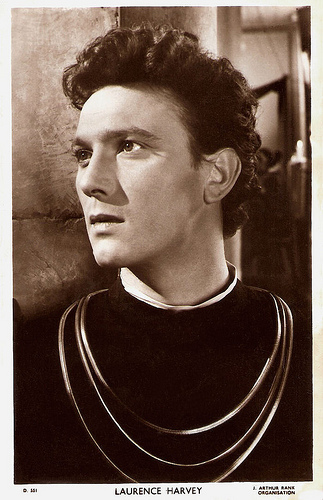
Laurence Harvey . British postcard in the Picturegoer series, London, no. D 551. Photo: J. Arthur Rank Organisation. Publicity still for Romeo and Juliet (1954).

Anouk Aimee . British postcard in the Picturegoer series, London, nr. W 826. Photo: J. Arthur Rank Organisation.

Adrienne Corri . British postcard in the Picturegoer Series, London, no. D 584. Photo: J. Arthur Rank Oragnisation.

Eva Bartok . British postcard in the Picturegoer Series, London, no. D 235. Photo: J. Arthur Rank Organisation.
The art of colorizing
Picturegoer was the only publishing company which attached a special importance to the art of colorizing. There are even small series dedicated to that art, Colourgraph, Cameo, Filmpartners.
The K series was devoted to cameo portraits and the P series to film partners. The K and P series were issued in b/w and coloured versions. The coloured versions were given the prefixes KC and PC but the poses were identical to the b/w versions. T
The C series, known as the Colourgraph Series, was devoted entirely to handcoloured images. The FS Series was related exclusively to film scenes. Special sets of different cards were issued for specific films in the D & W Series.
The individual card numbers are only listed on the reverse side of each card. Also the company name can be seen there. The production took place in a gentle sepia brown and in light version. The cards have the regular postcard size.
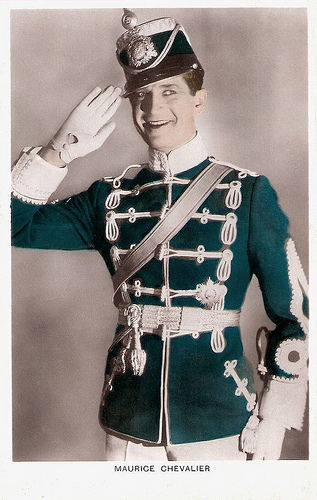
Maurice Chevalier . British postcard in the Colourgraph series, London, no. C 64.
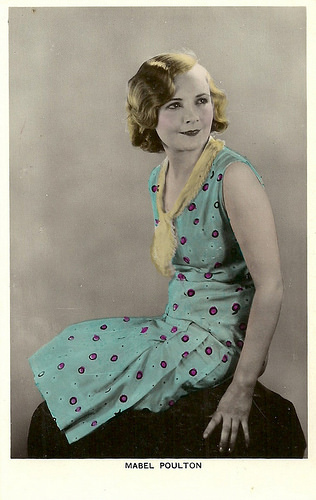
Mabel Poulton . British postcard in the Colourgraph Series, London, no. C 82.
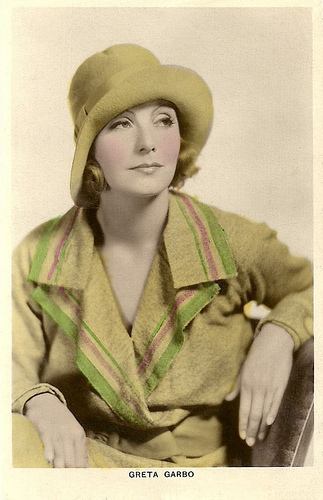
Greta Garbo . British postcard in the Colourgraph Series, London, no. C 81.
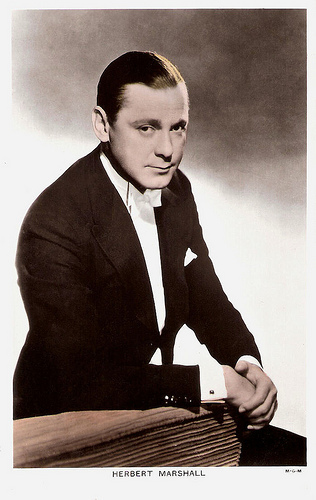
Herbert Marshall . British postcard in the Colourgraph Series, London, no. C 233. Photo: M.G.M.
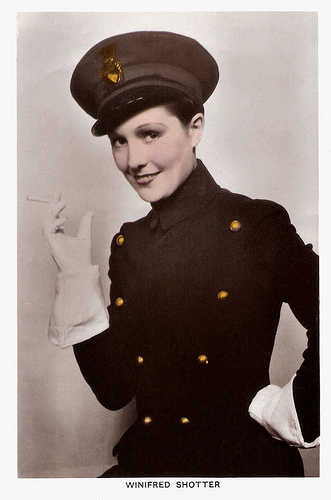
Winifred Shotter . British postcard in the Colourgraph Series, London, no. C 146.
Good Reputation
Also the postcard series with names such as Colourgraph, Famous Filmpartner Cards, Film Shots (= Film Weekly) and Filmkurier Series were all produced by the Picturegoer company.
Not only postcards and magazines established a good reputation for Picturegoer. They also produced nice supplements within the magazines (film programs), annual film books or other nice memorabilia.
After World War II, Picturegoer magazine found itself competing with periodicals published by the Rank Organisation, Odeon Cinemas, and Associated British Cinemas, which replaced Picturegoer with their own magazines at their theatre kiosks. As a result, Picturegoer became more sensational in the 1950s, with covers featuring cheesecake and beefcake-style artwork.
Picturegoer eventually merged with the pop music magazine Disc Date. Shortly after the Picturegoer name was dropped and the publication concentrated solely on music. The last issue of Picturegoer was published on 23 April 23, 1960 with a cover showcasing Jackie Rae and Janette Scott.
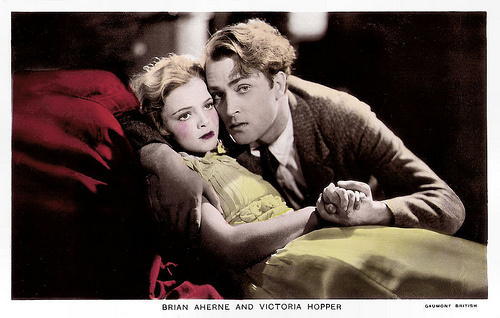
Brian Aherne and Victoria Hopper in The Constant Nymph (1933). British Real Photograph postcard in the Film Partners series, no. P 121. Photo: Gaumont-British. Publicity still for The Constant Nymph (Basil Dean, 1933).
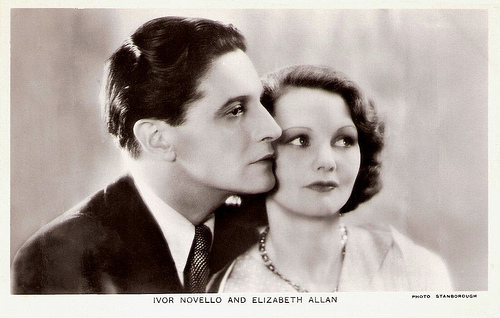
Ivor Novello and Elizabeth Allan . British postcard in the Film Partners series, no. P 41. Photo: Stanborough.
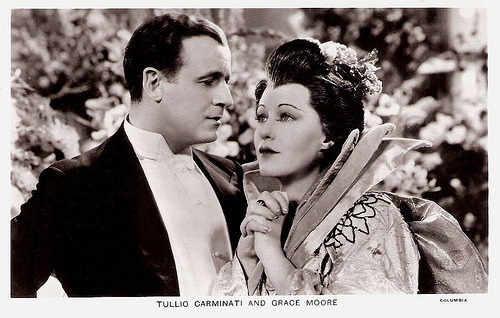
Tullio Carminati and Grace Moore in One Night of Love. British postcard in the Film Partners Series, London, no. P 151. Photo: Columbia. Publicity still for One Night of Love (Victor Schertzinger, 1934).
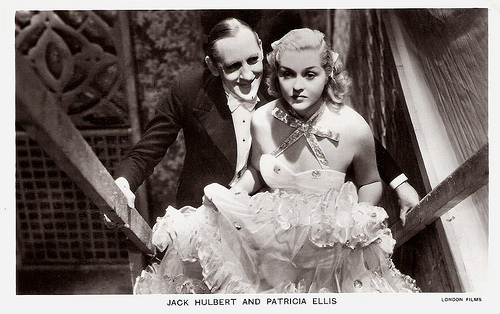
Jack Hulbert and Patricia Ellis in Paradise for Two. British postcard in the Film Partners Series, London, no. P 241. Photo: London Films. Publicity still for Paradise for Two/Gaiety Girls (Thornton Freeland, 1937).
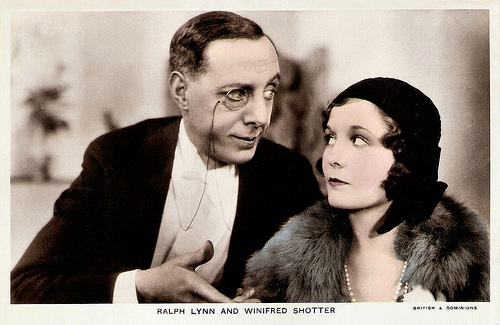
Ralph Lynn and Winifred Shotter . British postcard in the Film Partners Series by Real Photograph, London, no. 81. Photo: British & Dominions.
This was the third post in a new series on film star postcard publishers. For earlier posts, see the links at right under the caption 'The Publishers'. Next Wednesday: France's CE or Cinemagazine Edition.
Sources: Garbo Forever, Immortal Ephemera, Wikipedia and IMDb.

Ivor Novello . British postcard in the Picturegoer series, London.

Mary Odette . British postcard in the Picturegoer Series, no. 190. Photo: Foulsham & Banfield. Collection: Marlene Pilaete.

Madeleine Carroll . British postcard in the Picturegoer series, London, no. 352a. Photo: Dorothy Wilding.

John Gielgud . British postcard in the Picturegoer Series, no. 762. Photo: Dorothy Wilding.

John Stuart . British postcard in the Picturegoer Series, London, no. 54e.
Fan Magazine
Picturegoer Magazine was published between January 1921 and 23 April 1960. As a fan magazine, its primary focus was on film and film stars in particular.
The magazine was published monthly until November 1925, then disappeared for a number of years, but reappeared 30 May 1931 as a weekly magazine, listing films showing at British cinemas when talkies became popular.
Eventually it became a bi-weekly movie magazine featuring the screen's biggest stars that was sold at all movie theatres. Greta Garbo , Marlene Dietrich , Anna Neagle , Laurence Olivier , Petula Clark, and Richard Burton were among the hundreds of stars who graced its front cover.

Greta Garbo . British postcard in the 'Picturegoer' Series, London, no. 2836.

Hedy Lamarr . British postcard in the Picturegoer series, London, no. W 200. Photo: Metro-Goldwyn-Mayer (MGM).

Peter Lorre . British postcard in the Picturegoer Series, London, no. 1033A. Photo: 20th Century Fox.

Victor McLaglen . British postcard in the Picturegoer series, London, no. 208b.

Erich von Stroheim . British postcard in the Picturegoer series, London, no. 20a. Photo: Fox.
Numbers
In the 1920s and 1940s each Picturegoer postcard measured 3-1/2" X 5-1/2", the regular postcard size. These were real photos with glossy finish on front.
On the back of each card is a number. The lettering after some of the numbers denotes the series that the card was from.
The postcards were issued in series, the first one, which ran to over 1400 cards, did not have any kind of prefix letter. The first series was followed by Series A, Series B, etc.
Groups of several poses of the same star were sometimes published in this series and were identified with an alphabetical suffix (e.g. Greta Garbo had cards published numbered 600, 600a, 600b, 600c, 600d, 600e, 600f, 600g, 600h which depicted 9 different images of the star for example).
Subsequent series were given a prefix letter with the majority of images being in sepia tone (e.g. W for those issued in the 1940s, D for the 1950s and S for the last series issued up to 1960).

Sabu . British postcard in the Picturegoer series, London, no. 1155. Photo: United Artists.

Laurence Harvey . British postcard in the Picturegoer series, London, no. D 551. Photo: J. Arthur Rank Organisation. Publicity still for Romeo and Juliet (1954).

Anouk Aimee . British postcard in the Picturegoer series, London, nr. W 826. Photo: J. Arthur Rank Organisation.

Adrienne Corri . British postcard in the Picturegoer Series, London, no. D 584. Photo: J. Arthur Rank Oragnisation.

Eva Bartok . British postcard in the Picturegoer Series, London, no. D 235. Photo: J. Arthur Rank Organisation.
The art of colorizing
Picturegoer was the only publishing company which attached a special importance to the art of colorizing. There are even small series dedicated to that art, Colourgraph, Cameo, Filmpartners.
The K series was devoted to cameo portraits and the P series to film partners. The K and P series were issued in b/w and coloured versions. The coloured versions were given the prefixes KC and PC but the poses were identical to the b/w versions. T
The C series, known as the Colourgraph Series, was devoted entirely to handcoloured images. The FS Series was related exclusively to film scenes. Special sets of different cards were issued for specific films in the D & W Series.
The individual card numbers are only listed on the reverse side of each card. Also the company name can be seen there. The production took place in a gentle sepia brown and in light version. The cards have the regular postcard size.

Maurice Chevalier . British postcard in the Colourgraph series, London, no. C 64.

Mabel Poulton . British postcard in the Colourgraph Series, London, no. C 82.

Greta Garbo . British postcard in the Colourgraph Series, London, no. C 81.

Herbert Marshall . British postcard in the Colourgraph Series, London, no. C 233. Photo: M.G.M.

Winifred Shotter . British postcard in the Colourgraph Series, London, no. C 146.
Good Reputation
Also the postcard series with names such as Colourgraph, Famous Filmpartner Cards, Film Shots (= Film Weekly) and Filmkurier Series were all produced by the Picturegoer company.
Not only postcards and magazines established a good reputation for Picturegoer. They also produced nice supplements within the magazines (film programs), annual film books or other nice memorabilia.
After World War II, Picturegoer magazine found itself competing with periodicals published by the Rank Organisation, Odeon Cinemas, and Associated British Cinemas, which replaced Picturegoer with their own magazines at their theatre kiosks. As a result, Picturegoer became more sensational in the 1950s, with covers featuring cheesecake and beefcake-style artwork.
Picturegoer eventually merged with the pop music magazine Disc Date. Shortly after the Picturegoer name was dropped and the publication concentrated solely on music. The last issue of Picturegoer was published on 23 April 23, 1960 with a cover showcasing Jackie Rae and Janette Scott.

Brian Aherne and Victoria Hopper in The Constant Nymph (1933). British Real Photograph postcard in the Film Partners series, no. P 121. Photo: Gaumont-British. Publicity still for The Constant Nymph (Basil Dean, 1933).

Ivor Novello and Elizabeth Allan . British postcard in the Film Partners series, no. P 41. Photo: Stanborough.

Tullio Carminati and Grace Moore in One Night of Love. British postcard in the Film Partners Series, London, no. P 151. Photo: Columbia. Publicity still for One Night of Love (Victor Schertzinger, 1934).

Jack Hulbert and Patricia Ellis in Paradise for Two. British postcard in the Film Partners Series, London, no. P 241. Photo: London Films. Publicity still for Paradise for Two/Gaiety Girls (Thornton Freeland, 1937).

Ralph Lynn and Winifred Shotter . British postcard in the Film Partners Series by Real Photograph, London, no. 81. Photo: British & Dominions.
This was the third post in a new series on film star postcard publishers. For earlier posts, see the links at right under the caption 'The Publishers'. Next Wednesday: France's CE or Cinemagazine Edition.
Sources: Garbo Forever, Immortal Ephemera, Wikipedia and IMDb.
Published on March 31, 2015 22:00
March 30, 2015
Kally Sambucini
Kally Sambucini was an Italian actress of the silent film. She was the companion of the well-known actor-director Emilio Ghione, and appeared as Za-La-Vie in his film series on the dark anti-hero Za-La-Mort. Her favourite film was Lo scaldino (Augusto Genina, 1920) based on a novel by Luigi Pirandello.

Italian postcard by Ed. G.B. Falci, Milano. Kally Sambucini's first name is misspelled here as Ely, but there was no actress Ely Sambucini.
Dark anti-hero
Kally Sambucini was a pseudonym of Calliope Sambucini, who was born in Rome in 1892.
Accredited as Kally Sam and Kelly Sambucini, she was the companion of the well-known Emilio Ghione . The couple had a son, Emilio Ghione jr., who was also an actor.
From 1915 Sambucini and her husband were also a couple on screen. They starred in the film series on the dark anti-hero Za-La-Mort, which was directed by Ghione himself.
Their films include Za-la-Mort (1915), L’imboscata/The ambush (1916), Il numero 121/Number 121 (1917) with Diana D'Amore, I topi grigi/The gray mice (1918), Dollari e fracks/Dollars and fracks (1919), Il castello di bronzo/The bronze castle (1920), Quale dei due?/Which one? (1922), Un frak e un apache/A frak and an apache (1923) with Rita D'Harcourt, and Ultimissime della note/News of the night (1924).
They also made a Za-la-Mort film in Germany: Za-la-mort/Die Traum der Za-la-Vie (1924), co-starring Fern Andra .
Sambucini's role in these films was the antithesis of Ghione’s character, his fragile wife Za-la-Vie.

Emilio Ghione. Italian postcard.

Emilio Ghione as Za-la-Mort. Italian postcard by Vettori, Bologna, no. 2011.
Taking Revenge
Kally Sambucini also acted in other films directed by Ghione, such as Anime buie/Dark souls (1915) with Hesperia .
She also played the female lead opposite Ghione in Senza padre/Fatherless (shot in 1924, but released in 1927), also with Maria Carmi .
Their last film together was La casa errante/The wandering house (1925).
She also acted in a few films by other directors. When asked in an interview in the 1950s what her favourite film performance had been, Sambucini debunked her Za-la-Vie parts.
She mentioned instead Lo scaldino/The warmer (1920) by Augusto Genina, based on a novel by Luigi Pirandello. In this film she co-starred with Franz Sala.
A shabby resale of cigars and newspapers is run every night by old Papa-Re (King Daddy), played by Alfonso Cassini, heated by an old clay warmer, which falls to pieces one day. That night the old man finds in his kiosk a singer (Sambucini) from the café-concert next door with a baby. The woman goes to shoot her lover, who dumped her. She takes revenge, flees and leaves her baby with the old man. The old man and the baby warm each other.
While Emilio Ghione earlier on had mentioned that the collaboration between director Augusto Genina and Sambucini had been very difficult because of Genina's cold, rational behaviour, Denis Lotti writes in his biography of Ghione that professional jealousy might have played a part in Ghione's statement.
Luigi Pirandello was glad with Sambucini's performance in Lo scaldino. The film press also raved about this realist tragedy and its true emotions.
After Ghione's death in 1930, Sambucini acted only in one sound film, Notte di fiamme/Night of flames (Ladislao Kish, 1942).
In 1947 Emilio Ghione Junior tried to bring to the fore the characters who had brought his parents their biggest success. He starred in the film La fumeria d’oppio/The Opium Den (Raffaello Matarazzo, 1947), but the film did not have the desired success.
Kally Sambucini died in Rome in 1969. She was 77.

Emilio Ghione. Italian postcard by Fotocelere.
Sources: Denis Lotti (Emilio Ghione, l'ultimo apache - Italian), and Wikipedia (English and Italian).

Italian postcard by Ed. G.B. Falci, Milano. Kally Sambucini's first name is misspelled here as Ely, but there was no actress Ely Sambucini.
Dark anti-hero
Kally Sambucini was a pseudonym of Calliope Sambucini, who was born in Rome in 1892.
Accredited as Kally Sam and Kelly Sambucini, she was the companion of the well-known Emilio Ghione . The couple had a son, Emilio Ghione jr., who was also an actor.
From 1915 Sambucini and her husband were also a couple on screen. They starred in the film series on the dark anti-hero Za-La-Mort, which was directed by Ghione himself.
Their films include Za-la-Mort (1915), L’imboscata/The ambush (1916), Il numero 121/Number 121 (1917) with Diana D'Amore, I topi grigi/The gray mice (1918), Dollari e fracks/Dollars and fracks (1919), Il castello di bronzo/The bronze castle (1920), Quale dei due?/Which one? (1922), Un frak e un apache/A frak and an apache (1923) with Rita D'Harcourt, and Ultimissime della note/News of the night (1924).
They also made a Za-la-Mort film in Germany: Za-la-mort/Die Traum der Za-la-Vie (1924), co-starring Fern Andra .
Sambucini's role in these films was the antithesis of Ghione’s character, his fragile wife Za-la-Vie.

Emilio Ghione. Italian postcard.

Emilio Ghione as Za-la-Mort. Italian postcard by Vettori, Bologna, no. 2011.
Taking Revenge
Kally Sambucini also acted in other films directed by Ghione, such as Anime buie/Dark souls (1915) with Hesperia .
She also played the female lead opposite Ghione in Senza padre/Fatherless (shot in 1924, but released in 1927), also with Maria Carmi .
Their last film together was La casa errante/The wandering house (1925).
She also acted in a few films by other directors. When asked in an interview in the 1950s what her favourite film performance had been, Sambucini debunked her Za-la-Vie parts.
She mentioned instead Lo scaldino/The warmer (1920) by Augusto Genina, based on a novel by Luigi Pirandello. In this film she co-starred with Franz Sala.
A shabby resale of cigars and newspapers is run every night by old Papa-Re (King Daddy), played by Alfonso Cassini, heated by an old clay warmer, which falls to pieces one day. That night the old man finds in his kiosk a singer (Sambucini) from the café-concert next door with a baby. The woman goes to shoot her lover, who dumped her. She takes revenge, flees and leaves her baby with the old man. The old man and the baby warm each other.
While Emilio Ghione earlier on had mentioned that the collaboration between director Augusto Genina and Sambucini had been very difficult because of Genina's cold, rational behaviour, Denis Lotti writes in his biography of Ghione that professional jealousy might have played a part in Ghione's statement.
Luigi Pirandello was glad with Sambucini's performance in Lo scaldino. The film press also raved about this realist tragedy and its true emotions.
After Ghione's death in 1930, Sambucini acted only in one sound film, Notte di fiamme/Night of flames (Ladislao Kish, 1942).
In 1947 Emilio Ghione Junior tried to bring to the fore the characters who had brought his parents their biggest success. He starred in the film La fumeria d’oppio/The Opium Den (Raffaello Matarazzo, 1947), but the film did not have the desired success.
Kally Sambucini died in Rome in 1969. She was 77.

Emilio Ghione. Italian postcard by Fotocelere.
Sources: Denis Lotti (Emilio Ghione, l'ultimo apache - Italian), and Wikipedia (English and Italian).
Published on March 30, 2015 22:00
March 29, 2015
Rik Battaglia (1927-2015)
On 27 March, Italian film actor Rik Battaglia (1927-2015) passed away. He made nearly 100 film appearances between 1954 and 1999. Battaglia played the bad guy in dozens of Peplums, Euro-Westerns and war films. In Germany he became notorious as ‘The Man Who Shot Winnetou.‘
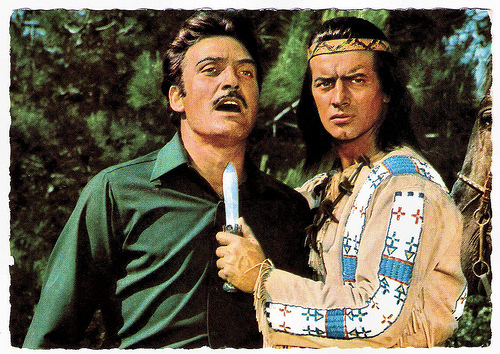
German postcard, no. 9 (1-32). Photo: Rialto / Constantin. Publicity still for Winnetou - 3. Teil/Winnetou: The Last Shot (Harald Reinl, 1965) with Pierre Brice as Winnetou.
Looking like a million lire
Rik Battaglia was born as Caterino Bertaglia in Corbola, Italy, in 1927 ( IMDb ) or 1930 ( Wikipedia ). Battaglia never met his father and has seen his mother only rarely. He was raised by his grandmother.
At 17, he was working as a sailor on a freighter between Corfu and the Black Sea. Years later, he was discovered by director Mario Soldati when he worked as a bartender in a Milanese restaurant. Producer Carlo Ponti hired him on the spot.
In his first film, La donna del fiume/The River Girl (Mario Soldati, 1954), he played a cigarette smuggler who has a tempestuous love affair with a young Sophia Loren (Ponti’s wife) in hot pants.
Hal Erickson at AllMovie : "The first half of the film plays for laughs, while the second half evolves into a lachrymose soap opera. Through it all, Sophia Loren looks like a million lire - and she even gets to sing and dance!" The film was an obvious attempt to recapture the success of Riso Amaro/Bitter Rice (Giuseppe De Santis, 1949) with Silvana Mangano .
After the success of the film, Battaglia attended a drama school for two years. Another attempt to cash in on Riso Amaro was La risaia/The Rice Girl (Raffaello Matarazzo, 1956), in which Battaglia appeared in the same kind of role opposite another sexy beauty, Elsa Martinelli .
He played supporting parts in the Peplums (Sandal and sword epics) La Gerusalemme liberate/The Mighty Crusaders (Carlo Ludovico Bragaglia, 1958) with Francisco Rabal and Sylva Koscina , Annibale/Hannibal (Carlo Ludovico Bragaglia, Edgar G. Ulmer, 1959) starring Victor Mature, and Giulio Cesare, il conquistatore delle Gallie/Caesar the Conqueror (Tanio Boccia, 1962).
In Germany he appeared as a slave merchant in the Liane-sequel Liane, die weiße Sklavin/Jungle Girl and the Slaver (Hermann Leitner, 1957) with Marion Michael , and he was seen in the Hollywood adventure Raw Wind in Eden (Richard Wilson, 1958) with Esther Williams and Jeff Chandler.

Italian postcard by Turismofoto, no. 86.

German postcard by Netter's Starverlag, Berlin.
Obscure Peplums
Rik Battaglia made one of his best films with La giornata balorda/A Crazy Day (Mauro Bolognini, 1961) opposite Jean Sorel and Lea Massari. Pier Paolo Pasolini co-wrote the screenplay for this black-and-white film about the lower class of Rome, based on a novel by Alberto Moravia.
One of his biggest flops was the biblical epic Sodom and Gomorrah (Robert Aldrich, 1962) with Stewart Granger and Pier Angeli . He appeared in several obscure peplums and such adventure films as Sandokan, la tigre di Mompracem/Sandokan the Great (Umberto Lenzi, 1963) with bodybuilder Steve Reeves.
Battaglia moved to Germany where he played in the Karl May Westerns Old Shatterhand (Hugo Fregonese, 1964), Der Schut/The Shoot (Robert Siodmak, 1964), Der Schatz der Azteken/The Treasure of the Aztecs (Robert Siodmak, 1965), Die Pyramide des Sonnengottes/Pyramid of the Sun God (Robert Siodmak, 1965), Winnetou - 3. Teil/Winnetou: The Last Shot (Harald Reinl, 1965) and Winnetou und Shatterhand im Tal der Toten/Winnetou and Shatterhand in the Valley of Death (Harald Reinl, 1968), all starring Lex Barker ; Das Vermächtnis des Inka/Legacy of the Incas (Georg Marischka, 1965) with Guy Madison, and Winnetou und sein Freund Old Firehand/Thunder at the Border (Alfred Vohrer, 1966), with Pierre Brice .
He was also the co-star of Freddy Quinn in the Schlager Western Freddy und das Lied der Prärie/In the Wild West (Sobey Martin, 1964). Battaglia had a German fan base in those years. That changed abruptly when he became Winnetou’s murderer in Winnetou - 3. Teil/Winnetou: The Last Shot (Harald Reinl, 1965).
Spaghettiwestern.net : "Previous to the film's release, production company Rialto hinted that Winnetou would be killed in the movie, which led to spontaneous protests organized by the children's magazines. Battaglia was booed at the premiere and later confessed that people continued complaining about his vile act for years, even though several films (all presented as prequels) had been made with Brice as Winnetou in the meantime. When (director Harald) Reinl asked him again for a Winnetou movie, he allegedly answered: Only if I don't have to kill the hero!".

German postcard by Kolibri-Verlag, Minden-Westf., no. 2751. Photo: Deutsche Cosmopol. Publicity still for I fidanzati della morte/The betrothed of death (Romolo Marcellini, 1957).
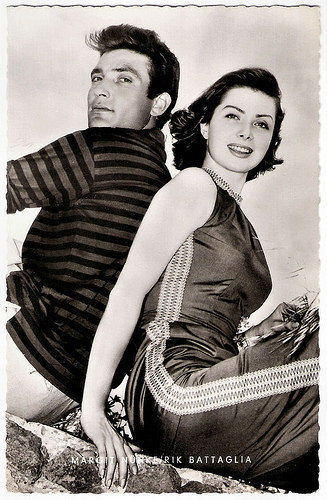
German postcard by Kunst und Bild, Berlin-Charlottenburg, no. T 850. Photo: Deutsche Cosmopol / Ringpress / Vogelmann. Publicity still for I fidanzati della morte/The betrothed of death (Romolo Marcellini, 1957) with Margit Nünke .
Spaghetti Westerns
Rik Battaglia returned to Italy to play in Spaghetti Westerns like Spara, Gringo, spara/Shoot, Gringo... Shoot! (Bruno Corbucci, 1968) and Black Jack (Gianfranco Baldanello, 1968).
The best of these was Sergio Leone's epic Giù la testa/Duck, You Sucker!/A Fistful of Dynamite (1971), which failed to gain any substantial recognition from the critics at the time of its premiere, especially compared to the maestro's other films. Leone only won a David di Donatello for Best Director, but the film has received a more favourable reception since then.
Keith Phibbs at AllMovie : "A fantastic opening pitting Rod Steiger's earthy bandito against a stagecoach filled with rich bigots begins the film on a fantastic note that Leone has difficulty sustaining. But what the film loses in momentum, it gains in complexity. Pairing Steiger's character with James Coburn's nearly disillusioned Irish revolutionary expands the scope of the film in ways other than the geographical. While other political spaghetti Westerns simply pitted the haves against the have-nots, Duck, You Sucker! (named after a 'popular' American catchphrase known only to Leone), attempts to portray the full scope of revolution. That the director includes chilling scenes of wholesale massacre on the part of the ruling class would seem to betray his sympathies, but he also portrays the impact of revolutionary activity on those who rebel. (...) Though it includes too many awkwardly paced passages to qualify as anyone's favourite Leone film, the film's disastrous financial performance in America granted it an undeserved obscurity. The strange (even by his own standards) score by Ennio Morricone alone makes it worth seeking out."
Battaglia then featured as Captain Smollett in Treasure Island (John Hough, 1972), one of the many film versions of the classic adventure by Robert Louis Stevenson, with Orson Welles as Long John Silver. In 1974 he appeared in the Agatha Christie adaptation Ein Unbekannter rechnet ab/Ten Little Indians (Peter Collinson, 1974) which also starred Richard Attenborough and Gert Frobe.
He also appeared in the Sergio Leone (co-)produced western Un genio, due compari, un pollo/The Genius (Damiano Damiani, 1975) starring Terence Hill. He mixed roles in such sexploitation films as Suor Emanuelle/Sister Emanuelle (Giuseppe Vari, 1977) with Laura Gemser with parts in mafia-dramas like Il prefetto di ferro/The Iron Prefect (Pasquale Squitteri, 1977) starring Giuliano Gemma and Claudia Cardinale , and an occasional spaghetti western like Mannaja/A Man Called Blade (Sergio Martino, 1977) with John Steiner.
Alternate names he used for his films were Rick Austin, Riccardo Battaglia and Rick Battaglia. His last feature film was Buck ai confini del cielo/Buck at the Edge of Heaven (Tonino Ricci, 1991) with John Savage.
In 1995, Rik Battaglia was awarded with the Scharlih, the oldest award associated with Karl May. He retired in 1999. On 27 March 2015, Battaglia died of heart failure at his home in Corbola in the province of Rovigo, Italy. He was 88.
German trailer for La donna del fiume/The River Girl (1954). Source: Arild Rafalzik (YouTube).
German trailer for Der Schut/The Shoot (1964). Source: Filmportal (YouTube).
German trailer for Winnetou und sein Freund Old Firehand/Thunder at the Border (1966). Source: Rialto Film (YouTube).
American trailer of Giù la testa/A Fistful of Dynamite (1971). Source: The Spaghetti Western Database (YouTube).
Sources: Hal Erickson (AllMovie), Keith Phibbs (AllMovie), La Repubblica (Italian)Tom B. (Westerns all...Italiana), Sebastian Haselbeck (Spaghettiwestern.net), Wikipedia and .

German postcard, no. 9 (1-32). Photo: Rialto / Constantin. Publicity still for Winnetou - 3. Teil/Winnetou: The Last Shot (Harald Reinl, 1965) with Pierre Brice as Winnetou.
Looking like a million lire
Rik Battaglia was born as Caterino Bertaglia in Corbola, Italy, in 1927 ( IMDb ) or 1930 ( Wikipedia ). Battaglia never met his father and has seen his mother only rarely. He was raised by his grandmother.
At 17, he was working as a sailor on a freighter between Corfu and the Black Sea. Years later, he was discovered by director Mario Soldati when he worked as a bartender in a Milanese restaurant. Producer Carlo Ponti hired him on the spot.
In his first film, La donna del fiume/The River Girl (Mario Soldati, 1954), he played a cigarette smuggler who has a tempestuous love affair with a young Sophia Loren (Ponti’s wife) in hot pants.
Hal Erickson at AllMovie : "The first half of the film plays for laughs, while the second half evolves into a lachrymose soap opera. Through it all, Sophia Loren looks like a million lire - and she even gets to sing and dance!" The film was an obvious attempt to recapture the success of Riso Amaro/Bitter Rice (Giuseppe De Santis, 1949) with Silvana Mangano .
After the success of the film, Battaglia attended a drama school for two years. Another attempt to cash in on Riso Amaro was La risaia/The Rice Girl (Raffaello Matarazzo, 1956), in which Battaglia appeared in the same kind of role opposite another sexy beauty, Elsa Martinelli .
He played supporting parts in the Peplums (Sandal and sword epics) La Gerusalemme liberate/The Mighty Crusaders (Carlo Ludovico Bragaglia, 1958) with Francisco Rabal and Sylva Koscina , Annibale/Hannibal (Carlo Ludovico Bragaglia, Edgar G. Ulmer, 1959) starring Victor Mature, and Giulio Cesare, il conquistatore delle Gallie/Caesar the Conqueror (Tanio Boccia, 1962).
In Germany he appeared as a slave merchant in the Liane-sequel Liane, die weiße Sklavin/Jungle Girl and the Slaver (Hermann Leitner, 1957) with Marion Michael , and he was seen in the Hollywood adventure Raw Wind in Eden (Richard Wilson, 1958) with Esther Williams and Jeff Chandler.

Italian postcard by Turismofoto, no. 86.

German postcard by Netter's Starverlag, Berlin.
Obscure Peplums
Rik Battaglia made one of his best films with La giornata balorda/A Crazy Day (Mauro Bolognini, 1961) opposite Jean Sorel and Lea Massari. Pier Paolo Pasolini co-wrote the screenplay for this black-and-white film about the lower class of Rome, based on a novel by Alberto Moravia.
One of his biggest flops was the biblical epic Sodom and Gomorrah (Robert Aldrich, 1962) with Stewart Granger and Pier Angeli . He appeared in several obscure peplums and such adventure films as Sandokan, la tigre di Mompracem/Sandokan the Great (Umberto Lenzi, 1963) with bodybuilder Steve Reeves.
Battaglia moved to Germany where he played in the Karl May Westerns Old Shatterhand (Hugo Fregonese, 1964), Der Schut/The Shoot (Robert Siodmak, 1964), Der Schatz der Azteken/The Treasure of the Aztecs (Robert Siodmak, 1965), Die Pyramide des Sonnengottes/Pyramid of the Sun God (Robert Siodmak, 1965), Winnetou - 3. Teil/Winnetou: The Last Shot (Harald Reinl, 1965) and Winnetou und Shatterhand im Tal der Toten/Winnetou and Shatterhand in the Valley of Death (Harald Reinl, 1968), all starring Lex Barker ; Das Vermächtnis des Inka/Legacy of the Incas (Georg Marischka, 1965) with Guy Madison, and Winnetou und sein Freund Old Firehand/Thunder at the Border (Alfred Vohrer, 1966), with Pierre Brice .
He was also the co-star of Freddy Quinn in the Schlager Western Freddy und das Lied der Prärie/In the Wild West (Sobey Martin, 1964). Battaglia had a German fan base in those years. That changed abruptly when he became Winnetou’s murderer in Winnetou - 3. Teil/Winnetou: The Last Shot (Harald Reinl, 1965).
Spaghettiwestern.net : "Previous to the film's release, production company Rialto hinted that Winnetou would be killed in the movie, which led to spontaneous protests organized by the children's magazines. Battaglia was booed at the premiere and later confessed that people continued complaining about his vile act for years, even though several films (all presented as prequels) had been made with Brice as Winnetou in the meantime. When (director Harald) Reinl asked him again for a Winnetou movie, he allegedly answered: Only if I don't have to kill the hero!".

German postcard by Kolibri-Verlag, Minden-Westf., no. 2751. Photo: Deutsche Cosmopol. Publicity still for I fidanzati della morte/The betrothed of death (Romolo Marcellini, 1957).

German postcard by Kunst und Bild, Berlin-Charlottenburg, no. T 850. Photo: Deutsche Cosmopol / Ringpress / Vogelmann. Publicity still for I fidanzati della morte/The betrothed of death (Romolo Marcellini, 1957) with Margit Nünke .
Spaghetti Westerns
Rik Battaglia returned to Italy to play in Spaghetti Westerns like Spara, Gringo, spara/Shoot, Gringo... Shoot! (Bruno Corbucci, 1968) and Black Jack (Gianfranco Baldanello, 1968).
The best of these was Sergio Leone's epic Giù la testa/Duck, You Sucker!/A Fistful of Dynamite (1971), which failed to gain any substantial recognition from the critics at the time of its premiere, especially compared to the maestro's other films. Leone only won a David di Donatello for Best Director, but the film has received a more favourable reception since then.
Keith Phibbs at AllMovie : "A fantastic opening pitting Rod Steiger's earthy bandito against a stagecoach filled with rich bigots begins the film on a fantastic note that Leone has difficulty sustaining. But what the film loses in momentum, it gains in complexity. Pairing Steiger's character with James Coburn's nearly disillusioned Irish revolutionary expands the scope of the film in ways other than the geographical. While other political spaghetti Westerns simply pitted the haves against the have-nots, Duck, You Sucker! (named after a 'popular' American catchphrase known only to Leone), attempts to portray the full scope of revolution. That the director includes chilling scenes of wholesale massacre on the part of the ruling class would seem to betray his sympathies, but he also portrays the impact of revolutionary activity on those who rebel. (...) Though it includes too many awkwardly paced passages to qualify as anyone's favourite Leone film, the film's disastrous financial performance in America granted it an undeserved obscurity. The strange (even by his own standards) score by Ennio Morricone alone makes it worth seeking out."
Battaglia then featured as Captain Smollett in Treasure Island (John Hough, 1972), one of the many film versions of the classic adventure by Robert Louis Stevenson, with Orson Welles as Long John Silver. In 1974 he appeared in the Agatha Christie adaptation Ein Unbekannter rechnet ab/Ten Little Indians (Peter Collinson, 1974) which also starred Richard Attenborough and Gert Frobe.
He also appeared in the Sergio Leone (co-)produced western Un genio, due compari, un pollo/The Genius (Damiano Damiani, 1975) starring Terence Hill. He mixed roles in such sexploitation films as Suor Emanuelle/Sister Emanuelle (Giuseppe Vari, 1977) with Laura Gemser with parts in mafia-dramas like Il prefetto di ferro/The Iron Prefect (Pasquale Squitteri, 1977) starring Giuliano Gemma and Claudia Cardinale , and an occasional spaghetti western like Mannaja/A Man Called Blade (Sergio Martino, 1977) with John Steiner.
Alternate names he used for his films were Rick Austin, Riccardo Battaglia and Rick Battaglia. His last feature film was Buck ai confini del cielo/Buck at the Edge of Heaven (Tonino Ricci, 1991) with John Savage.
In 1995, Rik Battaglia was awarded with the Scharlih, the oldest award associated with Karl May. He retired in 1999. On 27 March 2015, Battaglia died of heart failure at his home in Corbola in the province of Rovigo, Italy. He was 88.
German trailer for La donna del fiume/The River Girl (1954). Source: Arild Rafalzik (YouTube).
German trailer for Der Schut/The Shoot (1964). Source: Filmportal (YouTube).
German trailer for Winnetou und sein Freund Old Firehand/Thunder at the Border (1966). Source: Rialto Film (YouTube).
American trailer of Giù la testa/A Fistful of Dynamite (1971). Source: The Spaghetti Western Database (YouTube).
Sources: Hal Erickson (AllMovie), Keith Phibbs (AllMovie), La Repubblica (Italian)Tom B. (Westerns all...Italiana), Sebastian Haselbeck (Spaghettiwestern.net), Wikipedia and .
Published on March 29, 2015 15:00
March 28, 2015
More rare postcards from the Cinema of the Russian Empire
Collector Didier Hanson has sent me again scans of very old and rare Russian film postcards from 'Mother Russia'. On 12 October and 19 February we already posted Didier's postcards of such silent stars as Vera Kholodnaya, Vera Karalli, Nathalie Kovanko, Vitold Polonsky and Ivan Khudoleyev. So, I am delighted to present you another post on the artists of the Russian theatre and cinema from the times of the last Czar.

Vladimir Strizhevsky and Lidiya F. Ryndina. Russian postcard, no. 74. Collection: Didier Hanson.
Russian director an actor Vladimir Strizhevsky worked in Russia, Germany and France. In 1915, Strizhevsky started to act in silent Russian films like Sashka-Seminarist (Cheslav Sabinsky, 1915), and Teni grekha (Pyotr Chardynin, 1915) with Vera Karalli. With director Yevgeni Bauer he made Grif starogo bortsa/Griffon of an Old Warrior (Yevgeni Bauer, 1916) also with Karalli, Nabat/The Alarm (Yevgeni Bauer, 1917) and Revolyutsioner/Revolutionary (Yevgeni Bauer, 1917). In Zhizn trekh dney/A life of three days (Gromov, 1917) , his co-star was Lidiya F. Ryndina (1884-1957).
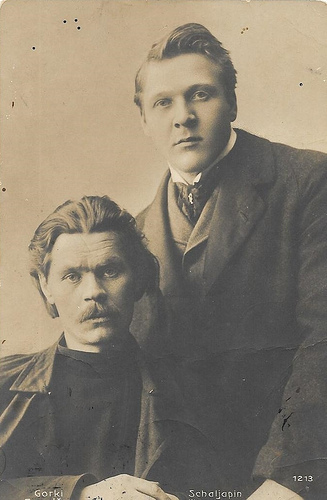
Maxim Gorky and Feodor Chaliapin. Russian postcard, no. 1213. Collection: Didier Hanson.
Maksim Gorky or Maxim Gorki was the pseudonym of Aleksey Maksimovich Peshkov (1868-1936). The Russian short-story writer and novelist first attracted attention with his naturalistic and sympathetic stories of tramps and social outcasts and later wrote other stories, novels, and plays, including his famous Na dne/The Lower Depths (1902). Mat/Mother (1906) is probably the least successful of his novels, yet it has considerable interest as Gorky’s only long work devoted to the Russian revolutionary movement. It was made into a notable silent film by Vsevolod Pudovkin (1926).
Feodor Ivanovich Chaliapin (Russian: Фёдор Ива́нович Шаля́пин) (1873–1938) was a Russian opera singer. The possessor of a large, deep and expressive bass voice, he enjoyed an important international career at major opera houses and is often credited with establishing the tradition of naturalistic acting in his chosen art form. His emigration from Russia in 1922, was painful. Soviet government stripped Chaliapin of all his titles and honours. He settled in Paris, France. There he performed at the Paris Opera, as well as at numerous private concerts for Sergei Diaghilev. His acting and singing was sensational. He made many sound recordings between the 1900 and 1938, of which the 1913 recordings of the Russian folk songs Vdol po Piterskoi and The Song of the Volga Boatmen are best known. The only sound film which shows his acting style is Don Quixote (Georg Wilhelm Pabst, 1933). Chaliapin collaborated with Maxim Gorky, who wrote and edited his memoirs, which he published in 1933.

Aleksandr R. Artem. Russian postcard. Collection: Didier Hanson.
Russian actor A. R. Artem (1842–1914) came late, in his forties, to the theatre, after a career as a visual artist. He became one of the star actors of the Moscow Art Theatre (MXAT) where he was noted as a character actor in the plays by Chekov, Gurky and Turgenev. Anton Chekhov mentioned him as his favourite actor.

Tatiana Pavlova. Italian postcard, no. 107. Photo: Ercole Massaglia, Torino. Collection: Didier Hanson.
Russian actress Tatiana (or Tatyana) Pavlova (1893-1975) first worked in the touring company of Pavel Orlenev and later in Moscow theatres. She made her Moscow debut in 1916 in the lead role of Fröken Julie/Miss Julie by August Strindberg. Following the revolution, she abandoned Moscow and worked in Paris, Odessa and Constantinople. In 1919 she went to Italy where she participated in silent films of the Ambrosio studio like La catena/The Chain (Alessandro Rosenfeld, Aleksandr Uralsky, 1920) with Ossip Runitsch . It was followed by other films by Rosenfeld and Uralsky, like L'Orchidea fatale (1920) again with Ossip Runitsch .

Ossip Runitsch . Russian postcard. Collection: Didier Hanson.
Russian actor, producer and stage director Ossip Runitsch (1889-1947) was one of the biggest stars of Russian silent cinema and one of the first iconic figures of Russian cinematograph.
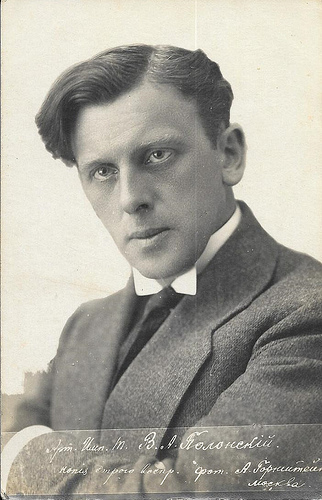
Vitold Polonsky. Russian postcard. Collection: Didier Hanson.
Vitold Polonsky (1879-1919) was one of the most popular actors in pre-Revolutionary Russian cinema.

Vera Kholodnaya . Russian postcard, no. 147. Collection: Didier Hanson.
Vera Kholodnaya (1893-1919) was the first star of the Russian silent cinema. Only 26, the ‘Queen of Screen’ died of the Spanish flu during the pandemic of 1919. Although she worked only three years for the cinema, she must have made between fifty and hundred short films. The Soviet authorities ordered to destroy many of the Kholodnaya features in 1924, and only five of her films still exist.

Vera Karalli . Russian postcard. Photo: publicity still for Krizantemy/Chrysanthemums (Pyotr Chardynin, 1914). Collection: Didier Hanson.
Vera Karalli (1889-1972) was a Russian ballet dancer, choreographer and actress in the early 20th century.

Aleksei Feona. Russian postcard. Collection: Didier Hanson.
Russian actor A.N. Feona starred in A Doll's House by Henrik Ibsen, when Mme. Vera F. Komisarzhevskaya Repertory performed the famous play on Broadway in March 1908. During the 1920s, he played in two Soviet films, Poet i tsar/The Poet and the Czar (Vladimir Gardin, Yevgeni Chervyakov, 1927) and Kastus Kalinovskiy (Vladimir Gardin, 1928).

Vasily Kachalov . Russian postcard. Collection: Didier Hanson.
Russian film and stage actor Vasily Kachalov (1875-1948) was one of Konstantin Stanislavsky's best known performers. He led the so-called Kachalov Group within the Moscow Art Theatre. He also appeared in four films.

Ivan Moskvin and Vasily Kachalov in The Lower Depths (1902). Russian postcard, no. 8572. Photo: publicity still for the Moscow Art Theatre production of The Lower Depths (1902) by Maxim Gorky, with Ivan Moskvin as Luka and Vasily Kachalov as the Baron. Collection: Didier Hanson.

Vasily Kachalov as Hamlet. Russian postcard. Photo: publicity still for The Moscow Art Theatre (MAT) production of Hamlet in 1911–1912. Collection: Didier Hanson.
Kachalov played Hamlet in the Symbolist production of 1911, created by two of the 20th century's most influential theatre practitioners—Konstantin Stanislavski and Edward Gordon Craig. Craig was an English theatre practitioner who had garnered interest for the symbolist and simplistic designs he brought to plays like Henrik Ibsen’s The Vikings at Helgeland. Konstantin Stanislavski was creating a world of theatre based upon realism, the internal complexities of the mind, and the rise of psychology. Their cooperation eventually gave birth to one of the most unique, polarizing, and impactful productions of all the twentieth century. Despite hostile reviews from the Russian press, the production attracted enthusiastic and unprecedented worldwide attention for the theatre, with reviews in Britain's The Times and in the French press that praised its unqualified success; the production placed the Moscow Art Theatre on the cultural map for Western Europe and it came to be regarded as a seminal event that influenced the subsequent history of production style in the theatre and revolutionised the staging of Shakespeare's plays in the 20th century. It became one of the most famous and passionately discussed productions in the history of the modern stage.
Didier, thank you.

Vladimir Strizhevsky and Lidiya F. Ryndina. Russian postcard, no. 74. Collection: Didier Hanson.
Russian director an actor Vladimir Strizhevsky worked in Russia, Germany and France. In 1915, Strizhevsky started to act in silent Russian films like Sashka-Seminarist (Cheslav Sabinsky, 1915), and Teni grekha (Pyotr Chardynin, 1915) with Vera Karalli. With director Yevgeni Bauer he made Grif starogo bortsa/Griffon of an Old Warrior (Yevgeni Bauer, 1916) also with Karalli, Nabat/The Alarm (Yevgeni Bauer, 1917) and Revolyutsioner/Revolutionary (Yevgeni Bauer, 1917). In Zhizn trekh dney/A life of three days (Gromov, 1917) , his co-star was Lidiya F. Ryndina (1884-1957).

Maxim Gorky and Feodor Chaliapin. Russian postcard, no. 1213. Collection: Didier Hanson.
Maksim Gorky or Maxim Gorki was the pseudonym of Aleksey Maksimovich Peshkov (1868-1936). The Russian short-story writer and novelist first attracted attention with his naturalistic and sympathetic stories of tramps and social outcasts and later wrote other stories, novels, and plays, including his famous Na dne/The Lower Depths (1902). Mat/Mother (1906) is probably the least successful of his novels, yet it has considerable interest as Gorky’s only long work devoted to the Russian revolutionary movement. It was made into a notable silent film by Vsevolod Pudovkin (1926).
Feodor Ivanovich Chaliapin (Russian: Фёдор Ива́нович Шаля́пин) (1873–1938) was a Russian opera singer. The possessor of a large, deep and expressive bass voice, he enjoyed an important international career at major opera houses and is often credited with establishing the tradition of naturalistic acting in his chosen art form. His emigration from Russia in 1922, was painful. Soviet government stripped Chaliapin of all his titles and honours. He settled in Paris, France. There he performed at the Paris Opera, as well as at numerous private concerts for Sergei Diaghilev. His acting and singing was sensational. He made many sound recordings between the 1900 and 1938, of which the 1913 recordings of the Russian folk songs Vdol po Piterskoi and The Song of the Volga Boatmen are best known. The only sound film which shows his acting style is Don Quixote (Georg Wilhelm Pabst, 1933). Chaliapin collaborated with Maxim Gorky, who wrote and edited his memoirs, which he published in 1933.

Aleksandr R. Artem. Russian postcard. Collection: Didier Hanson.
Russian actor A. R. Artem (1842–1914) came late, in his forties, to the theatre, after a career as a visual artist. He became one of the star actors of the Moscow Art Theatre (MXAT) where he was noted as a character actor in the plays by Chekov, Gurky and Turgenev. Anton Chekhov mentioned him as his favourite actor.

Tatiana Pavlova. Italian postcard, no. 107. Photo: Ercole Massaglia, Torino. Collection: Didier Hanson.
Russian actress Tatiana (or Tatyana) Pavlova (1893-1975) first worked in the touring company of Pavel Orlenev and later in Moscow theatres. She made her Moscow debut in 1916 in the lead role of Fröken Julie/Miss Julie by August Strindberg. Following the revolution, she abandoned Moscow and worked in Paris, Odessa and Constantinople. In 1919 she went to Italy where she participated in silent films of the Ambrosio studio like La catena/The Chain (Alessandro Rosenfeld, Aleksandr Uralsky, 1920) with Ossip Runitsch . It was followed by other films by Rosenfeld and Uralsky, like L'Orchidea fatale (1920) again with Ossip Runitsch .

Ossip Runitsch . Russian postcard. Collection: Didier Hanson.
Russian actor, producer and stage director Ossip Runitsch (1889-1947) was one of the biggest stars of Russian silent cinema and one of the first iconic figures of Russian cinematograph.

Vitold Polonsky. Russian postcard. Collection: Didier Hanson.
Vitold Polonsky (1879-1919) was one of the most popular actors in pre-Revolutionary Russian cinema.

Vera Kholodnaya . Russian postcard, no. 147. Collection: Didier Hanson.
Vera Kholodnaya (1893-1919) was the first star of the Russian silent cinema. Only 26, the ‘Queen of Screen’ died of the Spanish flu during the pandemic of 1919. Although she worked only three years for the cinema, she must have made between fifty and hundred short films. The Soviet authorities ordered to destroy many of the Kholodnaya features in 1924, and only five of her films still exist.

Vera Karalli . Russian postcard. Photo: publicity still for Krizantemy/Chrysanthemums (Pyotr Chardynin, 1914). Collection: Didier Hanson.
Vera Karalli (1889-1972) was a Russian ballet dancer, choreographer and actress in the early 20th century.

Aleksei Feona. Russian postcard. Collection: Didier Hanson.
Russian actor A.N. Feona starred in A Doll's House by Henrik Ibsen, when Mme. Vera F. Komisarzhevskaya Repertory performed the famous play on Broadway in March 1908. During the 1920s, he played in two Soviet films, Poet i tsar/The Poet and the Czar (Vladimir Gardin, Yevgeni Chervyakov, 1927) and Kastus Kalinovskiy (Vladimir Gardin, 1928).

Vasily Kachalov . Russian postcard. Collection: Didier Hanson.
Russian film and stage actor Vasily Kachalov (1875-1948) was one of Konstantin Stanislavsky's best known performers. He led the so-called Kachalov Group within the Moscow Art Theatre. He also appeared in four films.

Ivan Moskvin and Vasily Kachalov in The Lower Depths (1902). Russian postcard, no. 8572. Photo: publicity still for the Moscow Art Theatre production of The Lower Depths (1902) by Maxim Gorky, with Ivan Moskvin as Luka and Vasily Kachalov as the Baron. Collection: Didier Hanson.

Vasily Kachalov as Hamlet. Russian postcard. Photo: publicity still for The Moscow Art Theatre (MAT) production of Hamlet in 1911–1912. Collection: Didier Hanson.
Kachalov played Hamlet in the Symbolist production of 1911, created by two of the 20th century's most influential theatre practitioners—Konstantin Stanislavski and Edward Gordon Craig. Craig was an English theatre practitioner who had garnered interest for the symbolist and simplistic designs he brought to plays like Henrik Ibsen’s The Vikings at Helgeland. Konstantin Stanislavski was creating a world of theatre based upon realism, the internal complexities of the mind, and the rise of psychology. Their cooperation eventually gave birth to one of the most unique, polarizing, and impactful productions of all the twentieth century. Despite hostile reviews from the Russian press, the production attracted enthusiastic and unprecedented worldwide attention for the theatre, with reviews in Britain's The Times and in the French press that praised its unqualified success; the production placed the Moscow Art Theatre on the cultural map for Western Europe and it came to be regarded as a seminal event that influenced the subsequent history of production style in the theatre and revolutionised the staging of Shakespeare's plays in the 20th century. It became one of the most famous and passionately discussed productions in the history of the modern stage.
Didier, thank you.
Published on March 28, 2015 22:00
March 27, 2015
Die Nibelungen (1966)
The West German fantasy film Die Nibelungen (Harald Reinl, 1966) was released in two parts, Siegfried and Kriemhilds Rache (Kriemhild's Revenge). The film, produced by Artur Brauner, starred Uwe Beyer, Karin Dor and Herbert Lom. The two films were a remake of the silent classic Die Nibelungen (Fritz Lang, 1924), which was in turn based on the Middle High German epic poem Das Nibelungenlied.

German postcard, no. 2. Photo: CCC / Constantin Film. Publicity still for Die Nibelungen, Teil 1 - Siegfried / Siegfried (Harald Reinl, 1966) with Uwe Beyer as Siegfried and Benno Hoffmann as Mime.
Caption: "Siegfried, der Sohn des Königs der Niederlande, zog aus, um Ruhm zu ernten. In der Schmiede von Mime schmiedet er eigenhändig sein Schwert Nothung. Eifersüchtig auf Siegfrieds Stärke, will des Schmieds Geselle ihn töten, doch Siegfried kommt ihn zuvor und steckt ihn nieder. Die Probe ergibt, dass Siegfrieds Schwert, durch Blut eines Alben erkaltet, härter als Eisen ist und ihn unsiegbar machen wird."
(Siegfried, son of the King of the Netherlands moved out, in order to reap fame. In the smithy of Mime, he personally forges his sword Excalibur. Jealous of Siegfried's strength, the blacksmith apprentice wants to kill him, but Siegfried comes before him and puts him down. The test shows that Siegfried's sword cooled by a blood of a dwarf is harder than iron and make him invincible).

German postcard, no. 3. Photo: CCC / Constantin Film. Publicity still for Die Nibelungen, Teil 1 - Siegfried / Siegfried (Harald Reinl, 1966) with Uwe Beyer as Siegfried.
Caption: "Seiner Stärke bewusst, zieht Siegfried aus, um Abenteuer zu bestehen. Vor allem will er sich des Schatzes der Nibelungen bemächtigen, der von dem feuerspeienden Drachen Fafnir gehütet wird. Nach hartem Kampf gelingt es ihm das Untier zu töten. Als er von seinem Blute kostet, versteht er die Stimmen der Vögel, die ihm raten, sich im Blute des Drachen zu baden, auf dass er unverwundbar werde. Während des Bades fällt ein Lindenblatt zwischen seinen Schultern. An dieser Stelle wird er verwundbar bleiben. Der Weg zur Höhle, wo der Schatz verborgen sein soll, ist nun frei, jedoch stehen ihm noch weitere Gefahren bevor."
(Conscious of his strength, Siegfried takes off to challenge adventure. Above all, he wants to take possession of the treasure of the Nibelungen, which is guarded by the fire-breathing dragon Fafnir. After a fierce battle, he manages to kill the monster. When he tastes of his blood, he understands the voices of the birds that advise him to bathe in the blood of the dragon, so that he may be invulnerable. During the bath a linden leaf falls between his shoulders. At this point, he will remain vulnerable. The path to the cave where the treasure should be hidden, is now free, but he finds himself facing further threats.)
Invulnerable and invisible
Siegfried von Xanten defeats the dragon Fafnir, and becomes invulnerable by bathing in the beast's blood. He then wins a net of invisibility and the legendary Treasure of the Nibelungen from the dwarf Alberich.
Siegfried falls in love with Kriemhild, sister of King Gunther of Burgund. However, Gunther will not allow Siegfried to marry her until he has helped Gunther to win a wife himself.
They travel to Iceland where Siegfried helps Gunther to defeat and win Queen Brunhild. They return to the Burgundian court at Worms and both weddings take place.
However, jealousy and envy cause frictions at the court. Intrigues eventually result in Hagen of Tronje killing Siegfried during a hunt.
In part 2, Kriemhild marries Etzel, king of the huns, in order to gain revenge for the murder of her husband. The Burgundians, led by Gunther and Hagen, follow an invitation after Kriemhild gives birth to Ortileb, and travel to Etzel's hall.
There they are attacked by the huns. Hagen kills Ortileb in the fight. There is a great slaughter and Gunther is killed. Finally Kriemhild kills Hagen and is then killed herself.

German postcard, no. 5. Photo: CCC / Constantin Film. Publicity still for Die Nibelungen, Teil 1 - Siegfried / Siegfried (Harald Reinl, 1966) with Uwe Beyer as Siegfried and Karin Dor as Brunhild.
Caption: "Es erfordert viel Mut, den Feuergürtel, der Burg Isenstein ergibt, zu durchbrechen. In der Burg findet Siegfried die schlafende Königin. Als er ihr den Ring an den Finger steckt, erwacht Brunhild wieder zum Leben. Der Bann ist gebrochen. Brunhild zeigt Siegfried ihr schönes Land und bittet ihn zu bleiben. Er aber will hinaus in die Welt, um Reiche zu erobern und Ruhm zu ernten. Zusammen mit Alberich gelangt Siegfried nach Worms, der stolzen Burg der Burgunder-Könige."
(It requires a lot of courage to break the ring of fire, which surrounds the castle Isenstein. In the castle Siegfried finds the sleeping queen. As he puts the ring on her finger, Brunhild comes back to life. The spell is broken. Brunhild shows Siegfried her beautiful country and asks him to stay. But he wants out to conquer the empires and become famous. Together with Alberich, Siegfried arrives in Worms, the proud castle of the Kings of Burgundy.)

German postcard, no. 6. Photo: CCC / Constantin Film. Publicity still for Die Nibelungen, Teil 1 - Siegfried / Siegfried (Harald Reinl, 1966) with Uwe Beyer as Siegfried and Rolf Henniger as King Gunther.
Caption: "In Worms wird Siegfried von König Gunther willkommen geheissen. Als er Kriemhild, Gunthers Schwester, erblickt, verliebt er sich in sie. Gleichzeitig bringen Boten die nachricht zu König Gunther, dass die Sachsen ins Burgunderland eingefallen seien. Siegfried erklärt sich sofort bereit, mit Hagen und den anderen Recken König Gunthers dem Feind entgegen zu eilen. Im Zweikampf besiegt Siegfried den König der Sachsen, unterwirft ihn und bringt ihn zu König Gunther. In Worms schwört dann der Sachsenkönig dem König von Burgund aufs Schwert ewige Treue."
(In Worms, Siegfried is welcomed by King Gunther. When he sees Kriemhild, Gunther's sister, he falls in love with her. At the same time, messengers bring the message to King Gunther, that the Saxons have invaded the Burgundy country. Siegfried immediately declares his willingness, with Hagen and the other knights to rush against King Gunther's enemy. In a duel Siegfried defeats the King of Saxony, subjects him and brings him to King Gunther. In Worms, the Saxon king then swears on his sword eternal fidelity to the king of Burgundy.)
Very old Germanic myths
The original source for the story was the Middle High German epic poem Das Nibelungenlied, likely written around the year 1200. This in turn was based on motifs from even older Germanic myths.
Although a new screenplay was written by Harald G. Petersson, Ladislas Fodor and director Harald Reinl, in many respects it followed the earlier version fairly closely.
In the late 1950s, German producer Artur Brauner had wanted Fritz Lang to remake his own silent film Die Nibelungen (1924) and had already informed the press that the project would go ahead.
However, in the fall of 1959, Lang energetically resisted this proposal, pointing out that it could be interpreted as Lang "not having anything new to say and being forced to fall back on successes of the past". Lang ended up making three films for Brauner that were in fact referencing his own past (Der Tiger von Eschnapur/The Tiger of Eschnapur (1959), Das indische Grabmal/The Indian Tomb (1959) and Die 1000 Augen des Dr. Mabuse/The Thousand Eyes of Dr. Mabuse (1960)).
It took another six years for Brauner to find the right director for his Nibelungen project. Harald Reinl had been the commercially most successful director of the 1950s and 1960s in Germany. But it was the vast box office success of his three Winnetou films - Der Schatz im Silbersee/The Treasure of the Silver Lake (1962), Winnetou - 1. Teil/Winnetou (1963), and Winnetou - 2. Teil/Winnetou: Last of the Renegades (1964) - that convinced Brauner that Reinl was the right man for the job.
Brauner wanted a disciplined worker who would respect budgets even without constant direct control by the producer, who could deal with large numbers of extras and who had experience shooting in Yugoslavia. Reinl also was fond of impressive landscape shots and, in conjunction with a symphonic music score, these were supposed to add gravitas to the story.

German postcard, no. 12. Photo: CCC / Constantin Film. Publicity still for Die Nibelungen, Teil 1 - Siegfried / Siegfried (Harald Reinl, 1967) with Siegfried Wischnewski as Hagen and Skip Martin as Alberich.
Caption: "Sturm umtost die Burg von Worms. Alberich, dem König von Xanten ergeben, und Hagen, der treue Ritter König Günthers, ahnen das kommende Unheil. Daraufhin schwört Hagen von Tronje mit erhobenem Schwert, jeden zu töten, der die Ehre seines Königs verlezt."
(Storm rages around the castle of Worms. Alberich, loyal to the king of Xanten, and Hagen, the faithful knight of king Gunther, suspect the coming disaster. Then Hagen swears with upraised sword to kill anyone who violates the honour of his king.)

German postcard, no. 13. Photo: CCC / Constantin Film. Publicity still for Die Nibelungen, Teil 1 - Siegfried / Siegfried (Harald Reinl, 1967) with Maria Marlow as Kriemhild and Karin Dor as Brunhild.
Caption: "Beim Kirchgang begegnen sich die Königinnen Kriemhild und Brunhild. Von Eifersucht geplagt, wirft Kriemhild der Königin von Burgund vor, dass nicht ihr Bruder Gunther, sondern Siegfried Brunhild besiegt hätte. Als Beweis zeigt sie Brunhild deren Zaubergürtel. Die Königinnen trennen sich in Zorn und Hass."
(When going to the church, the queens Kriemhild and Brunhild encounter. From jealousy plagued Kriemhild tells the Queen of Burgundy that not her brother Gunther but Siegfried has defeated Brunhild. As proof, she points Brunhild the magic belt. The queens separate in anger and hatred.)
The most expensive post-war film in West Germany
Die Nibelungen was produced by Artur Brauner's CCC Filmkunst in cooperation with Belgrad-based Avala Film. Both parts were shot back-to-back between 20 April and 20 October 1966. Locations included what was then Yugoslavia (today's Serbia: Sremska Rača, Smederevo fortress and Slovenia: Postojna Cave) as well as Iceland, and Spain (Ciudad Encantada and Cuenca).
Interiors were shot at CCC-Studios in Berlin-Spandau and at the Avala-Studios in Belgrad. To save on costs, the large-scale sets (the court at Worms and Etzel's Hall) were constructed in the Belgrad studios. However, this was the limit of the cooperation with Avala and the total cost of Die Nibelungen reportedly came to 8 million DM, which would have made it the most expensive post-war film in West Germany at the time.
According to a survey conducted by the Allensbach Institute prior to shooting, 35% of participants wanted to see a film about the hero Siegfried, but he had to be blonde and played by an unknown actor. Uwe Beyer, an olympic hammer thrower (Bronze medalist in 1964) was selected to play Siegfried. He had no prior acting experience and was dubbed by Thomas Danneberg in postproduction.
Siegfried, the first part of Die Nibelungen premiered on 13 December 1966 at Mathäser-Filmpalast in Munich. Kriemhilds Rache followed on 16 February 1967. Both were released by Constantin Film.
The films were very successful commercially. Siegfried was awarded the 'Goldene Leinwand' (Golden Screen) in 1967 for more than 3 million tickets sold within 18 months in West Germany. Critics were unimpressed, however.
In 1976, the film was re-released as a single film of 110 minutes length, also titled Die Nibelungen. It was released again in 1982 under the title Das Schwert der Nibelungen.

German postcard, no. 14. Photo: CCC / Constantin Film. Publicity still for Die Nibelungen, Teil 1 - Siegfried / Siegfried (Harald Reinl, 1967) with Maria Marlow as Kriemhild and Siegfried Wischnewski as Hagen.
Caption: "Nun hält Hagen von Tronje seine Stunde für gekommen. Er hasst Siegfried weil der Unruhe und Streit an den Hof von Burgund gebracht hat. Hagen redet Kriemhild ein, er wollte Siegfried vor jeder Gefahr beschützen. Sie müsse Ihm dazu genau die Stelle an Siegfrieds Körper bezeichnen wo Ihm beim Batt in Drachenblut ein Lindenblatt verwundbar bleiben liess. Kriemhild vertraut Hagen und bereut dies später bitter."
(Now Hagen von Tronje considers his hour has come. He hates Siegfried because of the unrest and dispute he has brought to the court of Burgundy. Hagen persuades Kriemhild that he wants to protect Siegfried from any danger. She must designate to him the exact spot on Siegfried's body where a lime leaf remained him vulnerable when he bathed in the dragon's blood. Kriemhild trusts Hagen and later regrets this bitterly.)

German postcard, no. 15. Photo: CCC / Constantin Film. Publicity still for Die Nibelungen, Teil 1 - Siegfried / Siegfried (Harald Reinl, 1967) with Uwe Beyer as Siegfried and Siegfried Wischnewski as Hagen.
Caption: "Hagen überredet König Gunther, zu Siegfrieds Abschied einen Jagdausflug zu veranstalten. Unter dem Vorwand, Siegfried eine nahe gelegene Quelle zu zeigen, lockt Hagen mit des Königs wissen diesen von der Jagdgesellschaft weg. Als sich Siegfried, Erfrischung suchend, über die Quelle neigt, trifft ihn Hagens wohlgezielter Speer an der verwundbaren Stelle. Vergebens bäumt sich Siegfried noch einmal auf."
(Hagen persuades King Gunther to organize a hunting trip as Siegfried's farewell. Under the pretext of showing Siegfried a nearby source, Hagen lures with the king know, him off the hunt. When Siegfried, searching for refreshment, leans over the source Hagen's well-aimed spear hits him on the vulnerable spot. In vain Siegfried rears up again.)
Trailer Die Nibelungen, Teil 1 - Siegfried / Siegfried (Harald Reinl, 1966). Source: R6dw6C (YouTube).
Trailer Die Nibelungen, Teil 2 - Kriemhilds Rache / Kriemhild's Revenge (Harald Reinl, 1966). Source: R6dw6C (YouTube).
Sources: Wikipedia and IMDb.

German postcard, no. 2. Photo: CCC / Constantin Film. Publicity still for Die Nibelungen, Teil 1 - Siegfried / Siegfried (Harald Reinl, 1966) with Uwe Beyer as Siegfried and Benno Hoffmann as Mime.
Caption: "Siegfried, der Sohn des Königs der Niederlande, zog aus, um Ruhm zu ernten. In der Schmiede von Mime schmiedet er eigenhändig sein Schwert Nothung. Eifersüchtig auf Siegfrieds Stärke, will des Schmieds Geselle ihn töten, doch Siegfried kommt ihn zuvor und steckt ihn nieder. Die Probe ergibt, dass Siegfrieds Schwert, durch Blut eines Alben erkaltet, härter als Eisen ist und ihn unsiegbar machen wird."
(Siegfried, son of the King of the Netherlands moved out, in order to reap fame. In the smithy of Mime, he personally forges his sword Excalibur. Jealous of Siegfried's strength, the blacksmith apprentice wants to kill him, but Siegfried comes before him and puts him down. The test shows that Siegfried's sword cooled by a blood of a dwarf is harder than iron and make him invincible).

German postcard, no. 3. Photo: CCC / Constantin Film. Publicity still for Die Nibelungen, Teil 1 - Siegfried / Siegfried (Harald Reinl, 1966) with Uwe Beyer as Siegfried.
Caption: "Seiner Stärke bewusst, zieht Siegfried aus, um Abenteuer zu bestehen. Vor allem will er sich des Schatzes der Nibelungen bemächtigen, der von dem feuerspeienden Drachen Fafnir gehütet wird. Nach hartem Kampf gelingt es ihm das Untier zu töten. Als er von seinem Blute kostet, versteht er die Stimmen der Vögel, die ihm raten, sich im Blute des Drachen zu baden, auf dass er unverwundbar werde. Während des Bades fällt ein Lindenblatt zwischen seinen Schultern. An dieser Stelle wird er verwundbar bleiben. Der Weg zur Höhle, wo der Schatz verborgen sein soll, ist nun frei, jedoch stehen ihm noch weitere Gefahren bevor."
(Conscious of his strength, Siegfried takes off to challenge adventure. Above all, he wants to take possession of the treasure of the Nibelungen, which is guarded by the fire-breathing dragon Fafnir. After a fierce battle, he manages to kill the monster. When he tastes of his blood, he understands the voices of the birds that advise him to bathe in the blood of the dragon, so that he may be invulnerable. During the bath a linden leaf falls between his shoulders. At this point, he will remain vulnerable. The path to the cave where the treasure should be hidden, is now free, but he finds himself facing further threats.)
Invulnerable and invisible
Siegfried von Xanten defeats the dragon Fafnir, and becomes invulnerable by bathing in the beast's blood. He then wins a net of invisibility and the legendary Treasure of the Nibelungen from the dwarf Alberich.
Siegfried falls in love with Kriemhild, sister of King Gunther of Burgund. However, Gunther will not allow Siegfried to marry her until he has helped Gunther to win a wife himself.
They travel to Iceland where Siegfried helps Gunther to defeat and win Queen Brunhild. They return to the Burgundian court at Worms and both weddings take place.
However, jealousy and envy cause frictions at the court. Intrigues eventually result in Hagen of Tronje killing Siegfried during a hunt.
In part 2, Kriemhild marries Etzel, king of the huns, in order to gain revenge for the murder of her husband. The Burgundians, led by Gunther and Hagen, follow an invitation after Kriemhild gives birth to Ortileb, and travel to Etzel's hall.
There they are attacked by the huns. Hagen kills Ortileb in the fight. There is a great slaughter and Gunther is killed. Finally Kriemhild kills Hagen and is then killed herself.

German postcard, no. 5. Photo: CCC / Constantin Film. Publicity still for Die Nibelungen, Teil 1 - Siegfried / Siegfried (Harald Reinl, 1966) with Uwe Beyer as Siegfried and Karin Dor as Brunhild.
Caption: "Es erfordert viel Mut, den Feuergürtel, der Burg Isenstein ergibt, zu durchbrechen. In der Burg findet Siegfried die schlafende Königin. Als er ihr den Ring an den Finger steckt, erwacht Brunhild wieder zum Leben. Der Bann ist gebrochen. Brunhild zeigt Siegfried ihr schönes Land und bittet ihn zu bleiben. Er aber will hinaus in die Welt, um Reiche zu erobern und Ruhm zu ernten. Zusammen mit Alberich gelangt Siegfried nach Worms, der stolzen Burg der Burgunder-Könige."
(It requires a lot of courage to break the ring of fire, which surrounds the castle Isenstein. In the castle Siegfried finds the sleeping queen. As he puts the ring on her finger, Brunhild comes back to life. The spell is broken. Brunhild shows Siegfried her beautiful country and asks him to stay. But he wants out to conquer the empires and become famous. Together with Alberich, Siegfried arrives in Worms, the proud castle of the Kings of Burgundy.)

German postcard, no. 6. Photo: CCC / Constantin Film. Publicity still for Die Nibelungen, Teil 1 - Siegfried / Siegfried (Harald Reinl, 1966) with Uwe Beyer as Siegfried and Rolf Henniger as King Gunther.
Caption: "In Worms wird Siegfried von König Gunther willkommen geheissen. Als er Kriemhild, Gunthers Schwester, erblickt, verliebt er sich in sie. Gleichzeitig bringen Boten die nachricht zu König Gunther, dass die Sachsen ins Burgunderland eingefallen seien. Siegfried erklärt sich sofort bereit, mit Hagen und den anderen Recken König Gunthers dem Feind entgegen zu eilen. Im Zweikampf besiegt Siegfried den König der Sachsen, unterwirft ihn und bringt ihn zu König Gunther. In Worms schwört dann der Sachsenkönig dem König von Burgund aufs Schwert ewige Treue."
(In Worms, Siegfried is welcomed by King Gunther. When he sees Kriemhild, Gunther's sister, he falls in love with her. At the same time, messengers bring the message to King Gunther, that the Saxons have invaded the Burgundy country. Siegfried immediately declares his willingness, with Hagen and the other knights to rush against King Gunther's enemy. In a duel Siegfried defeats the King of Saxony, subjects him and brings him to King Gunther. In Worms, the Saxon king then swears on his sword eternal fidelity to the king of Burgundy.)
Very old Germanic myths
The original source for the story was the Middle High German epic poem Das Nibelungenlied, likely written around the year 1200. This in turn was based on motifs from even older Germanic myths.
Although a new screenplay was written by Harald G. Petersson, Ladislas Fodor and director Harald Reinl, in many respects it followed the earlier version fairly closely.
In the late 1950s, German producer Artur Brauner had wanted Fritz Lang to remake his own silent film Die Nibelungen (1924) and had already informed the press that the project would go ahead.
However, in the fall of 1959, Lang energetically resisted this proposal, pointing out that it could be interpreted as Lang "not having anything new to say and being forced to fall back on successes of the past". Lang ended up making three films for Brauner that were in fact referencing his own past (Der Tiger von Eschnapur/The Tiger of Eschnapur (1959), Das indische Grabmal/The Indian Tomb (1959) and Die 1000 Augen des Dr. Mabuse/The Thousand Eyes of Dr. Mabuse (1960)).
It took another six years for Brauner to find the right director for his Nibelungen project. Harald Reinl had been the commercially most successful director of the 1950s and 1960s in Germany. But it was the vast box office success of his three Winnetou films - Der Schatz im Silbersee/The Treasure of the Silver Lake (1962), Winnetou - 1. Teil/Winnetou (1963), and Winnetou - 2. Teil/Winnetou: Last of the Renegades (1964) - that convinced Brauner that Reinl was the right man for the job.
Brauner wanted a disciplined worker who would respect budgets even without constant direct control by the producer, who could deal with large numbers of extras and who had experience shooting in Yugoslavia. Reinl also was fond of impressive landscape shots and, in conjunction with a symphonic music score, these were supposed to add gravitas to the story.

German postcard, no. 12. Photo: CCC / Constantin Film. Publicity still for Die Nibelungen, Teil 1 - Siegfried / Siegfried (Harald Reinl, 1967) with Siegfried Wischnewski as Hagen and Skip Martin as Alberich.
Caption: "Sturm umtost die Burg von Worms. Alberich, dem König von Xanten ergeben, und Hagen, der treue Ritter König Günthers, ahnen das kommende Unheil. Daraufhin schwört Hagen von Tronje mit erhobenem Schwert, jeden zu töten, der die Ehre seines Königs verlezt."
(Storm rages around the castle of Worms. Alberich, loyal to the king of Xanten, and Hagen, the faithful knight of king Gunther, suspect the coming disaster. Then Hagen swears with upraised sword to kill anyone who violates the honour of his king.)

German postcard, no. 13. Photo: CCC / Constantin Film. Publicity still for Die Nibelungen, Teil 1 - Siegfried / Siegfried (Harald Reinl, 1967) with Maria Marlow as Kriemhild and Karin Dor as Brunhild.
Caption: "Beim Kirchgang begegnen sich die Königinnen Kriemhild und Brunhild. Von Eifersucht geplagt, wirft Kriemhild der Königin von Burgund vor, dass nicht ihr Bruder Gunther, sondern Siegfried Brunhild besiegt hätte. Als Beweis zeigt sie Brunhild deren Zaubergürtel. Die Königinnen trennen sich in Zorn und Hass."
(When going to the church, the queens Kriemhild and Brunhild encounter. From jealousy plagued Kriemhild tells the Queen of Burgundy that not her brother Gunther but Siegfried has defeated Brunhild. As proof, she points Brunhild the magic belt. The queens separate in anger and hatred.)
The most expensive post-war film in West Germany
Die Nibelungen was produced by Artur Brauner's CCC Filmkunst in cooperation with Belgrad-based Avala Film. Both parts were shot back-to-back between 20 April and 20 October 1966. Locations included what was then Yugoslavia (today's Serbia: Sremska Rača, Smederevo fortress and Slovenia: Postojna Cave) as well as Iceland, and Spain (Ciudad Encantada and Cuenca).
Interiors were shot at CCC-Studios in Berlin-Spandau and at the Avala-Studios in Belgrad. To save on costs, the large-scale sets (the court at Worms and Etzel's Hall) were constructed in the Belgrad studios. However, this was the limit of the cooperation with Avala and the total cost of Die Nibelungen reportedly came to 8 million DM, which would have made it the most expensive post-war film in West Germany at the time.
According to a survey conducted by the Allensbach Institute prior to shooting, 35% of participants wanted to see a film about the hero Siegfried, but he had to be blonde and played by an unknown actor. Uwe Beyer, an olympic hammer thrower (Bronze medalist in 1964) was selected to play Siegfried. He had no prior acting experience and was dubbed by Thomas Danneberg in postproduction.
Siegfried, the first part of Die Nibelungen premiered on 13 December 1966 at Mathäser-Filmpalast in Munich. Kriemhilds Rache followed on 16 February 1967. Both were released by Constantin Film.
The films were very successful commercially. Siegfried was awarded the 'Goldene Leinwand' (Golden Screen) in 1967 for more than 3 million tickets sold within 18 months in West Germany. Critics were unimpressed, however.
In 1976, the film was re-released as a single film of 110 minutes length, also titled Die Nibelungen. It was released again in 1982 under the title Das Schwert der Nibelungen.

German postcard, no. 14. Photo: CCC / Constantin Film. Publicity still for Die Nibelungen, Teil 1 - Siegfried / Siegfried (Harald Reinl, 1967) with Maria Marlow as Kriemhild and Siegfried Wischnewski as Hagen.
Caption: "Nun hält Hagen von Tronje seine Stunde für gekommen. Er hasst Siegfried weil der Unruhe und Streit an den Hof von Burgund gebracht hat. Hagen redet Kriemhild ein, er wollte Siegfried vor jeder Gefahr beschützen. Sie müsse Ihm dazu genau die Stelle an Siegfrieds Körper bezeichnen wo Ihm beim Batt in Drachenblut ein Lindenblatt verwundbar bleiben liess. Kriemhild vertraut Hagen und bereut dies später bitter."
(Now Hagen von Tronje considers his hour has come. He hates Siegfried because of the unrest and dispute he has brought to the court of Burgundy. Hagen persuades Kriemhild that he wants to protect Siegfried from any danger. She must designate to him the exact spot on Siegfried's body where a lime leaf remained him vulnerable when he bathed in the dragon's blood. Kriemhild trusts Hagen and later regrets this bitterly.)

German postcard, no. 15. Photo: CCC / Constantin Film. Publicity still for Die Nibelungen, Teil 1 - Siegfried / Siegfried (Harald Reinl, 1967) with Uwe Beyer as Siegfried and Siegfried Wischnewski as Hagen.
Caption: "Hagen überredet König Gunther, zu Siegfrieds Abschied einen Jagdausflug zu veranstalten. Unter dem Vorwand, Siegfried eine nahe gelegene Quelle zu zeigen, lockt Hagen mit des Königs wissen diesen von der Jagdgesellschaft weg. Als sich Siegfried, Erfrischung suchend, über die Quelle neigt, trifft ihn Hagens wohlgezielter Speer an der verwundbaren Stelle. Vergebens bäumt sich Siegfried noch einmal auf."
(Hagen persuades King Gunther to organize a hunting trip as Siegfried's farewell. Under the pretext of showing Siegfried a nearby source, Hagen lures with the king know, him off the hunt. When Siegfried, searching for refreshment, leans over the source Hagen's well-aimed spear hits him on the vulnerable spot. In vain Siegfried rears up again.)
Trailer Die Nibelungen, Teil 1 - Siegfried / Siegfried (Harald Reinl, 1966). Source: R6dw6C (YouTube).
Trailer Die Nibelungen, Teil 2 - Kriemhilds Rache / Kriemhild's Revenge (Harald Reinl, 1966). Source: R6dw6C (YouTube).
Sources: Wikipedia and IMDb.
Published on March 27, 2015 23:00
March 26, 2015
De Wama's
De Wama's was a Dutch comedy duo consisting of Wim van Wageningen (1918-1986) and Dick de Maat (1917-1980). The duo was popular in Dutch variety shows in the 1940s, 1950s and 1960s. Together and solo, they were often seen on TV and also in Dutch films. In 1973 De Wama's parted.

Dutch postcard. Photo: Decca.

Dutch postcard, no. 1 62 D 724. Photo: Decca.
Need for light entertainment
Wim van Wageningen (1918-1986) and Dick de Maat (1917-1980) met in the army after mobilization. In 1940 they decided to become artists and form a duo. As a name for the new duo they chose ‘De Wama's’, the first two letters of their surnames, Van Wageningen and De Maat. They took on the stage names Wim Wama and Dick Wama.
After the war De Wama's continued as professional artists. They took advantage of the need for light entertainment that arose after 1945.
In the late 40s they wrote the song Naar de TT Race (To the TT race) on the motorcycling event Dutch TT in the city of Assen. It became a hit. Other famous songs from that period are Hotsjek and Ping en Pong (1955, Ping and Pong), about two ping pong playing Chinese.
Their occasional performances in the popular radio show De bonte dinsdagavondtrein (The colourful Tuesday Night Train) made them nationally known. As a result, they were much sought after artists on the gig circuit, where they became famous for their practical jokes, both on and off stage. Wim did a great Popeye imitation and Dick made fun of the Swedish diva Zarah Leander with a silk shawl and a cigarette pipe.
From the 1960s on, the popularity of vaudeville diminished and thus the popularity of De Wama's. They were not very innovative and in contrast to another popular duo, De Mounties, De Wama’s were little seen on television.
In the 1960s they had success with parodies of famous hit songs. Their covers include Mack the Knife by Bobby Darin and Laila by Die Regento Stars, both in 1960. Their Dutch version of Kriminal tango, which was a hit in West Germany for the Hazy Osterwald Sextett, made the Dutch charts in 1960. In 1962 the Wama's pulled again the charts by responding to the twist craze. They built Franz Liszt's Liebestraum into the Liebestraum twist.

Dutch postcard.

Dutch postcard, no. 5 60 D 24. Photo: Decca.
Hadjememaar
Around Carnival 1971 the Wama's had their final hit with A Ha, Dat Is Marie (Aha that is Marie), a cover of the French song La petit Marie by Jean Marie Mourou & Nicolas Péridès. Then De Wama's focused on theatre.
In 1971 they played small roles in the play Liefde is Hadjememaar (Love is Hadjememaar) of the Amsterdam Volkstoneel, led by Beppie Nooij. Here it appeared that Wim Wama had good acting skills.
In March 1973, De Wama's parted, but they retained their stage names, Wim Wama and Dick Wama.
Wim Wama had in the 1970s and 1980s success as an actor, both in the theatre, on TV and in films. He was also a voice actor for several foreign animated series. He spoke the voices of Jerom and Krimson in the puppet series Suske en Wiske/Spike and Suzy (1975) and he performed in radio plays including the popular series De Brekers (The Breakers) with Piet Römer.
His films include the war drama Pastorale 1943 (Wim Verstappen, 1978), the thriller De schorpioen/The Scorpion (Ben Verbong, 1984) and the prostitution drama Gebroken spiegels/Broken mirrors (Marleen Gorris, 1984).
He had his biggest stage role in 1984 with the part of hobo, street musician and local politician Hadjememaar in the remake of the play Liefde is Hadjememaar (Love is Hadjememaar) from 1971. In 1986, he would star in the play In Holland staat een huis (In Holland there is a house), but he was seriously ill that year. At the age of 67, he died from cancer in 1986.
Dick Wama had an alcohol addiction and was as an actor much less successful than Wim. Later he also landed in a wheelchair after a car accident. He died in 1980 at the age of 63 in Amsterdam from a stomach haemorrhage.

Dutch postcard, no. D 1196. Photo: Decca.

Dutch postcard by Gebr. Spanjersberg, Rotterdam (Sparo).
De Wama's perform Kriminal Tango. Source: Creepingyves (YouTube).
Sources: Wikipedia (Dutch) and .

Dutch postcard. Photo: Decca.

Dutch postcard, no. 1 62 D 724. Photo: Decca.
Need for light entertainment
Wim van Wageningen (1918-1986) and Dick de Maat (1917-1980) met in the army after mobilization. In 1940 they decided to become artists and form a duo. As a name for the new duo they chose ‘De Wama's’, the first two letters of their surnames, Van Wageningen and De Maat. They took on the stage names Wim Wama and Dick Wama.
After the war De Wama's continued as professional artists. They took advantage of the need for light entertainment that arose after 1945.
In the late 40s they wrote the song Naar de TT Race (To the TT race) on the motorcycling event Dutch TT in the city of Assen. It became a hit. Other famous songs from that period are Hotsjek and Ping en Pong (1955, Ping and Pong), about two ping pong playing Chinese.
Their occasional performances in the popular radio show De bonte dinsdagavondtrein (The colourful Tuesday Night Train) made them nationally known. As a result, they were much sought after artists on the gig circuit, where they became famous for their practical jokes, both on and off stage. Wim did a great Popeye imitation and Dick made fun of the Swedish diva Zarah Leander with a silk shawl and a cigarette pipe.
From the 1960s on, the popularity of vaudeville diminished and thus the popularity of De Wama's. They were not very innovative and in contrast to another popular duo, De Mounties, De Wama’s were little seen on television.
In the 1960s they had success with parodies of famous hit songs. Their covers include Mack the Knife by Bobby Darin and Laila by Die Regento Stars, both in 1960. Their Dutch version of Kriminal tango, which was a hit in West Germany for the Hazy Osterwald Sextett, made the Dutch charts in 1960. In 1962 the Wama's pulled again the charts by responding to the twist craze. They built Franz Liszt's Liebestraum into the Liebestraum twist.

Dutch postcard.

Dutch postcard, no. 5 60 D 24. Photo: Decca.
Hadjememaar
Around Carnival 1971 the Wama's had their final hit with A Ha, Dat Is Marie (Aha that is Marie), a cover of the French song La petit Marie by Jean Marie Mourou & Nicolas Péridès. Then De Wama's focused on theatre.
In 1971 they played small roles in the play Liefde is Hadjememaar (Love is Hadjememaar) of the Amsterdam Volkstoneel, led by Beppie Nooij. Here it appeared that Wim Wama had good acting skills.
In March 1973, De Wama's parted, but they retained their stage names, Wim Wama and Dick Wama.
Wim Wama had in the 1970s and 1980s success as an actor, both in the theatre, on TV and in films. He was also a voice actor for several foreign animated series. He spoke the voices of Jerom and Krimson in the puppet series Suske en Wiske/Spike and Suzy (1975) and he performed in radio plays including the popular series De Brekers (The Breakers) with Piet Römer.
His films include the war drama Pastorale 1943 (Wim Verstappen, 1978), the thriller De schorpioen/The Scorpion (Ben Verbong, 1984) and the prostitution drama Gebroken spiegels/Broken mirrors (Marleen Gorris, 1984).
He had his biggest stage role in 1984 with the part of hobo, street musician and local politician Hadjememaar in the remake of the play Liefde is Hadjememaar (Love is Hadjememaar) from 1971. In 1986, he would star in the play In Holland staat een huis (In Holland there is a house), but he was seriously ill that year. At the age of 67, he died from cancer in 1986.
Dick Wama had an alcohol addiction and was as an actor much less successful than Wim. Later he also landed in a wheelchair after a car accident. He died in 1980 at the age of 63 in Amsterdam from a stomach haemorrhage.

Dutch postcard, no. D 1196. Photo: Decca.

Dutch postcard by Gebr. Spanjersberg, Rotterdam (Sparo).
De Wama's perform Kriminal Tango. Source: Creepingyves (YouTube).
Sources: Wikipedia (Dutch) and .
Published on March 26, 2015 23:00
March 25, 2015
Claus Wilcke
German actor Claus Wilcke (1931) appeared in more than 20 films, but is best known for his roles in the German TV shows Percy Stuart (1969), and I.O.B. Spezialauftrag (1980). He has also dubbed many American actors including Elvis Presley and Warren Beatty for cinema and TV.

Dutch postcard by Gebr. Spanjersberg, Rotterdam, no. 4488. Photo: Ufa / Erwin Schneider.

German postcard by Kolibri-Verlag, Minden/Westf., no. 588. Photo: Interwest / Europa / Reuter. Publicity still for Meine 99 Bräute/My 99 Brides (Alfred Vohrer, 1958).

German postcard by Kolibri / Friedrich W. Sander Verlag, Minden/Westf., no. 3138. Photo: Electrola / Jung.
Suburb Playboy
Claus Wilcke was born in Bremen, Germany, in 1931. He had a classic acting training and graduated, trained for stunts in London and played many sports such as fencing and riding. For four year he worked for the Bremer Theater.
In 1958 the attractive young actor made his cinema debut as a suburb playboy in Meine 99 Bräute/My 99 brides (Alfred Vohrer, 1958).
This first leading role was followed by smaller roles in a series of well-made crime dramas: Verbrechen nach Schulschluß/The Young Go Wild (Alfred Vohrer, 1959), the biographical Die Wahrheit über Rosemarie/The Truth about Rosemarie (Rudolf Jugert, 1959) with Belinda Lee as the legendary call-girl, Am Tag, als der Regen kam/The Day the Rains Came (Gerd Oswald, 1959) with Mario Adorf, Lampenfieber/Lamp Fever (Kurt Hoffmann, 1960) and Via Mala (Paul May, 1961) starring Gert Fröbe and Joachim Hansen .
He played another lead role opposite Hannelore Elsner in Das Mädchen mit den schmalen Hüften/The girl with the slim hips (Johannes Kai, 1961).

German postcard by Kolibri-Verlag, Minden /Westf., no. 1222. Photo: Kolibri / Filipp.

German postcard by Kolibri-Verlag, Minden/Westf., no. 650. Photo: Kolibri / Erwin Schneider.

German postcard by Kolibri-Verlag, Minden/Westf., no. 692. Photo: Kolibri / Erwin Schneider.

German postcard by Kolibri-Verlag, Minden/Westf., no. 375. Photo: Interwest / Europa / Ringpress / Vogelmann. Publicity still for Meine 99 Bräute/My 99 brides (Alfred Vohrer, 1958).
Dynamic millionaire detective
During the 1960s, the German cinema was in a crisis and Claus Wilcke – like many other German film actors – focused on stage and television.
He guest-starred in episodes of Krimi series like Das Kriminalmuseum/The Criminal Museum (1963), John Klings Abenteuer/John Kling (1965), and Kommissar Brahm/Commissionar Brahm (1967) starring Paul Klinger .
In 1969 he was cast for the title role in the Krimi series Percy Stuart (1969-1972). The role of the dynamic millionaire detective made him incredibly popular in Germany. Nearly all of his stunts were done by himself because the insurance companies back then didn't hinder him.
Later he played roles in numerous other German TV shows, including the Krimi I.O.B. Spezialauftrag/I.O.B. special order (1980-1981) and on theatre stages all over Germany, Switzerland and Austria. More than 600 times, he played in the comedy Irma la Douce.
He was also a very sought-after voice-over actor. He was the German voice of Elvis Presley, Omar Sharif (in Lawrence von Arabien/Lawrence of Arabia), George Hamilton and Warren Beatty.
Incidentally he appeared in feature films. He played a lead in the comedy Halt die Luft an alter Gauner - Der Stockfisch und das Stinktier/Hold the air for the old rascals - The stockfish and the skunk (Günter Goldhammer, Peter Harlos, 1976).
More recently, he had a cameo appearance in Iron Sky (Timo Vuorensola, 2012), a sci-fi comedy about Nazis from the moon. He played the white-bearded Russian representative at the international conference who repeatedly laughs at the fictitious President of the United States until he gets angry and throws a shoe at her.
Claus Wilcke was married three times. His current wife is Beate Eckhardt. He has two children, the actors Nicolas Böll and Alexandra Wilcke.

German postcard. Photo: Optagon / Hamburgische Film- und Fernseh Produktion / ZDF. Publicity still for the TV series Percy Stuart (1969).

German postcard by Electrola, no. 1. Photo: Peter Michaelis, Hamburg.

German autograph card. Photo: Tele-Optagon.
Trailer for Percy Stuart (1969-1972). Source: ARDVideo (YouTube).
Sources: Stephanie D’heil (Steffi-Line), Wikipedia (English and German), and .

Dutch postcard by Gebr. Spanjersberg, Rotterdam, no. 4488. Photo: Ufa / Erwin Schneider.

German postcard by Kolibri-Verlag, Minden/Westf., no. 588. Photo: Interwest / Europa / Reuter. Publicity still for Meine 99 Bräute/My 99 Brides (Alfred Vohrer, 1958).

German postcard by Kolibri / Friedrich W. Sander Verlag, Minden/Westf., no. 3138. Photo: Electrola / Jung.
Suburb Playboy
Claus Wilcke was born in Bremen, Germany, in 1931. He had a classic acting training and graduated, trained for stunts in London and played many sports such as fencing and riding. For four year he worked for the Bremer Theater.
In 1958 the attractive young actor made his cinema debut as a suburb playboy in Meine 99 Bräute/My 99 brides (Alfred Vohrer, 1958).
This first leading role was followed by smaller roles in a series of well-made crime dramas: Verbrechen nach Schulschluß/The Young Go Wild (Alfred Vohrer, 1959), the biographical Die Wahrheit über Rosemarie/The Truth about Rosemarie (Rudolf Jugert, 1959) with Belinda Lee as the legendary call-girl, Am Tag, als der Regen kam/The Day the Rains Came (Gerd Oswald, 1959) with Mario Adorf, Lampenfieber/Lamp Fever (Kurt Hoffmann, 1960) and Via Mala (Paul May, 1961) starring Gert Fröbe and Joachim Hansen .
He played another lead role opposite Hannelore Elsner in Das Mädchen mit den schmalen Hüften/The girl with the slim hips (Johannes Kai, 1961).

German postcard by Kolibri-Verlag, Minden /Westf., no. 1222. Photo: Kolibri / Filipp.

German postcard by Kolibri-Verlag, Minden/Westf., no. 650. Photo: Kolibri / Erwin Schneider.

German postcard by Kolibri-Verlag, Minden/Westf., no. 692. Photo: Kolibri / Erwin Schneider.

German postcard by Kolibri-Verlag, Minden/Westf., no. 375. Photo: Interwest / Europa / Ringpress / Vogelmann. Publicity still for Meine 99 Bräute/My 99 brides (Alfred Vohrer, 1958).
Dynamic millionaire detective
During the 1960s, the German cinema was in a crisis and Claus Wilcke – like many other German film actors – focused on stage and television.
He guest-starred in episodes of Krimi series like Das Kriminalmuseum/The Criminal Museum (1963), John Klings Abenteuer/John Kling (1965), and Kommissar Brahm/Commissionar Brahm (1967) starring Paul Klinger .
In 1969 he was cast for the title role in the Krimi series Percy Stuart (1969-1972). The role of the dynamic millionaire detective made him incredibly popular in Germany. Nearly all of his stunts were done by himself because the insurance companies back then didn't hinder him.
Later he played roles in numerous other German TV shows, including the Krimi I.O.B. Spezialauftrag/I.O.B. special order (1980-1981) and on theatre stages all over Germany, Switzerland and Austria. More than 600 times, he played in the comedy Irma la Douce.
He was also a very sought-after voice-over actor. He was the German voice of Elvis Presley, Omar Sharif (in Lawrence von Arabien/Lawrence of Arabia), George Hamilton and Warren Beatty.
Incidentally he appeared in feature films. He played a lead in the comedy Halt die Luft an alter Gauner - Der Stockfisch und das Stinktier/Hold the air for the old rascals - The stockfish and the skunk (Günter Goldhammer, Peter Harlos, 1976).
More recently, he had a cameo appearance in Iron Sky (Timo Vuorensola, 2012), a sci-fi comedy about Nazis from the moon. He played the white-bearded Russian representative at the international conference who repeatedly laughs at the fictitious President of the United States until he gets angry and throws a shoe at her.
Claus Wilcke was married three times. His current wife is Beate Eckhardt. He has two children, the actors Nicolas Böll and Alexandra Wilcke.

German postcard. Photo: Optagon / Hamburgische Film- und Fernseh Produktion / ZDF. Publicity still for the TV series Percy Stuart (1969).

German postcard by Electrola, no. 1. Photo: Peter Michaelis, Hamburg.

German autograph card. Photo: Tele-Optagon.
Trailer for Percy Stuart (1969-1972). Source: ARDVideo (YouTube).
Sources: Stephanie D’heil (Steffi-Line), Wikipedia (English and German), and .
Published on March 25, 2015 23:00
March 24, 2015
Iris Verlag
What Ross Verlag meant for Germany, Iris Verlag did for Austria. Iris was a very popular and internationally known publishing company specialized in film star postcards. It operated from Vienna during the 1920s and 1930s. Unfortunately we could obtain just a tiny bit of information about this interesting Austrian company.
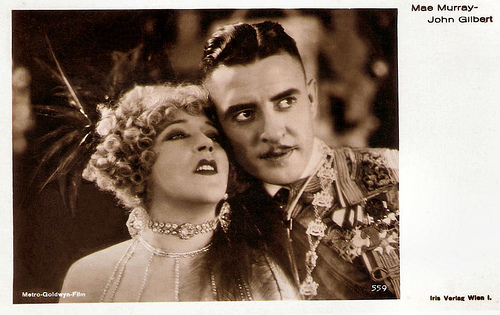
Mae Murray and John Gilbert in The Merry Widow. Austrian postcard by Iris Verlag, no. 559. Photo: Metro-Goldwyn-Film. Publicity still for The Merry Widow (Erich von Stroheim, 1925).

Ramon Novarro and Claire McDowell in Ben-Hur. Austrian postcard by Iris Verlag, no. 715/4. Photo: MGM. Publicity still for Ben-Hur: A Tale of the Christ (Fred Niblo, 1925).

Clive Brook and Billie Dove in Yellow Lily. Austrian postcard by Iris Verlag, no. 5416. Photo: Verleih Philipp & Co. / First National. Publicity still for Yellow Lily (Alexander Korda, 1928).
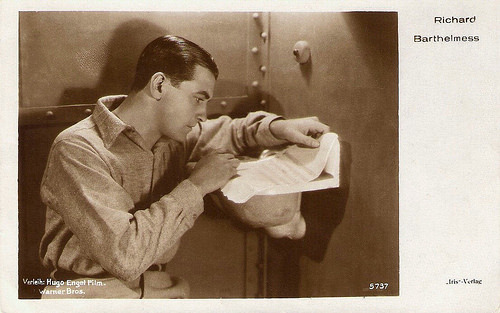
Richard Barthelmess. Austrian postcard by Iris Verlag, no. 5737. Photo: Hugo Engel Film / Warner Bros.
Sepia
A big difference between Ross Verlag and Iris-Verlag is the fact that Iris was just producing one special postcard format (14 x 9 cm). Iris didn't publish any scene cards in a series like Ross did or any luxury cards, art sheets or miniature cards.
Early Iris cards came out in a sepia brown tone. A few years later, at the beginning of the 1930s, the production of all following cards was handled in another quality which reminded more of a black/white motive.
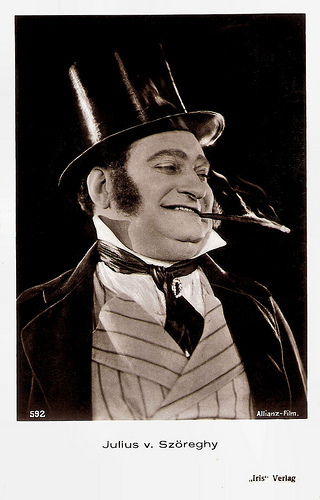
Julius von Szöreghy . Austrian postcard by Iris Verlag, no. 592. Photo: Allianz Film.

Lily Damita . Austrian postcard by Iris Verlag, no. 980. Photo: Sascha-Film.

Jack Trevor . Austrian postcard by Iris-Verlag, no. 5006. Photo: Sascha.

Ruth Weyher . Austrian postcard by Iris Verlag, no. 5059. Photo: Manassé, Wien.

Ita Rina . Austrian postcard by Iris-Verlag, no. 5118. Photo: Kiesel, Berlin.

Josephine Baker . Austrian postcard by Iris Verlag, no. 5293. Photo: Walery, Paris.
Confusion
Iris-Verlag published its cards in vertical and in horizontal formats. The listing of the different card numbers is a little bit uncommon. You can see the numbers on the lower left card edge or the right one or even within the photograph itself on the left or right side.
To make the confusion complete, Iris placed the numbers even on the reverse side of the cards, beginning from number 5954 till the end of the whole production. From that number on you can also see the addition 'Amag' above 'Iris' and the individual card number.

Bernhard Goetzke . Austrian postcard by Iris Verlag, no. 677/2. Photo: Verleih E. Weil & Co.

Vivian Gibson . Austrian postcard by Iris Verlag, no. 998. Photo: Emelka.

Elisabeth Bergner . Austrian postcard by Iris Verlag, no. 5689. Photo: Poetic Film / Lux-Film Verleih.

Marianne Winkelstern . Austrian postcard by Iris, no. 6514. Photo: Lux Film Verleih.

Jan Kiepura . Austrian Postcard by Iris Verlag. Photo: Lux Film / Cine-Allianz. Still from Das Lied einer Nacht (Anatole Litvak, 1932).
Colorized Cards
On the front side of the cards you can always read the name of the pictured persons and the origin where the photograph does come from. A copyright index is not given.
In the same manner as Ross Verlag did, Iris-Verlag produced some colorized cards as well. The handling was similar to Ross.
This was all the info we could find at the net, thanks to these enthusiastic contributors of the wonderful site Garbo Forever . Do you know more? Please share!

Emil Jannings . Austrian postcard by Iris Verlag, no. 970. Photo: Verleih Philipp & Co.
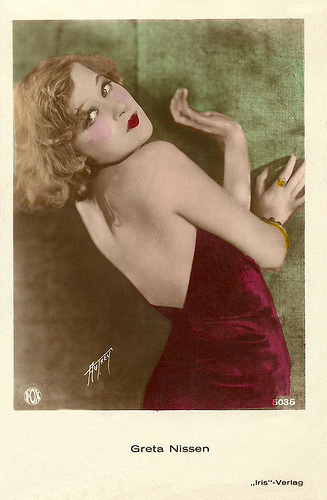
Greta Nissen . German postcard by Iris Verlag, no. 5035. Photo: Autrey / Fox.

Jaque Catelain . Austrian postcard by Iris Verlag, no. 824. Photo: Isabey, Paris.

Reginald Denny . Austrian postcard by Iris Verlag.

Vilma Banky . Austrian postcard by Iris Verlag, no. 975. Photo: Halasz, Budapest.
This was the second post in a new series on film star postcard publishers. For earlier posts, see the links at right under the caption 'The Publishers'. Next Wednesday: the British phenomenon of Picturegoer.
Source: Garbo Forever. See also our Iris-Verlag album at Flickr.

Mae Murray and John Gilbert in The Merry Widow. Austrian postcard by Iris Verlag, no. 559. Photo: Metro-Goldwyn-Film. Publicity still for The Merry Widow (Erich von Stroheim, 1925).

Ramon Novarro and Claire McDowell in Ben-Hur. Austrian postcard by Iris Verlag, no. 715/4. Photo: MGM. Publicity still for Ben-Hur: A Tale of the Christ (Fred Niblo, 1925).

Clive Brook and Billie Dove in Yellow Lily. Austrian postcard by Iris Verlag, no. 5416. Photo: Verleih Philipp & Co. / First National. Publicity still for Yellow Lily (Alexander Korda, 1928).

Richard Barthelmess. Austrian postcard by Iris Verlag, no. 5737. Photo: Hugo Engel Film / Warner Bros.
Sepia
A big difference between Ross Verlag and Iris-Verlag is the fact that Iris was just producing one special postcard format (14 x 9 cm). Iris didn't publish any scene cards in a series like Ross did or any luxury cards, art sheets or miniature cards.
Early Iris cards came out in a sepia brown tone. A few years later, at the beginning of the 1930s, the production of all following cards was handled in another quality which reminded more of a black/white motive.

Julius von Szöreghy . Austrian postcard by Iris Verlag, no. 592. Photo: Allianz Film.

Lily Damita . Austrian postcard by Iris Verlag, no. 980. Photo: Sascha-Film.

Jack Trevor . Austrian postcard by Iris-Verlag, no. 5006. Photo: Sascha.

Ruth Weyher . Austrian postcard by Iris Verlag, no. 5059. Photo: Manassé, Wien.

Ita Rina . Austrian postcard by Iris-Verlag, no. 5118. Photo: Kiesel, Berlin.

Josephine Baker . Austrian postcard by Iris Verlag, no. 5293. Photo: Walery, Paris.
Confusion
Iris-Verlag published its cards in vertical and in horizontal formats. The listing of the different card numbers is a little bit uncommon. You can see the numbers on the lower left card edge or the right one or even within the photograph itself on the left or right side.
To make the confusion complete, Iris placed the numbers even on the reverse side of the cards, beginning from number 5954 till the end of the whole production. From that number on you can also see the addition 'Amag' above 'Iris' and the individual card number.

Bernhard Goetzke . Austrian postcard by Iris Verlag, no. 677/2. Photo: Verleih E. Weil & Co.

Vivian Gibson . Austrian postcard by Iris Verlag, no. 998. Photo: Emelka.

Elisabeth Bergner . Austrian postcard by Iris Verlag, no. 5689. Photo: Poetic Film / Lux-Film Verleih.

Marianne Winkelstern . Austrian postcard by Iris, no. 6514. Photo: Lux Film Verleih.

Jan Kiepura . Austrian Postcard by Iris Verlag. Photo: Lux Film / Cine-Allianz. Still from Das Lied einer Nacht (Anatole Litvak, 1932).
Colorized Cards
On the front side of the cards you can always read the name of the pictured persons and the origin where the photograph does come from. A copyright index is not given.
In the same manner as Ross Verlag did, Iris-Verlag produced some colorized cards as well. The handling was similar to Ross.
This was all the info we could find at the net, thanks to these enthusiastic contributors of the wonderful site Garbo Forever . Do you know more? Please share!

Emil Jannings . Austrian postcard by Iris Verlag, no. 970. Photo: Verleih Philipp & Co.

Greta Nissen . German postcard by Iris Verlag, no. 5035. Photo: Autrey / Fox.

Jaque Catelain . Austrian postcard by Iris Verlag, no. 824. Photo: Isabey, Paris.

Reginald Denny . Austrian postcard by Iris Verlag.

Vilma Banky . Austrian postcard by Iris Verlag, no. 975. Photo: Halasz, Budapest.
This was the second post in a new series on film star postcard publishers. For earlier posts, see the links at right under the caption 'The Publishers'. Next Wednesday: the British phenomenon of Picturegoer.
Source: Garbo Forever. See also our Iris-Verlag album at Flickr.
Published on March 24, 2015 23:00
March 23, 2015
Jole Ferrari
Italian starlet Jole Ferrari had a short career playing supporting parts in the Italian cinema of the 1930s and 1940s. Among her film are Alessandro Blasetti's Un'avventura di Salvator Rosa (1939), the opera adaptation L'elisir d'amore (1941) and the historical drama Luisa Sanfelice (1942).

Italian postcard by ASER, no. 147. Photo: Luxardo.
Robin Hood, Neapolitan Style
In 1939, Jole Ferrari started her film career with a small part in the Swashbuckler Un' avventura di Salvator Rosa/An Adventure of Salvator Rosa (Alessandro Blasetti, 1939) starring Gino Cervi and Luise Ferida .
Gerald A. De Luca at IMDb : "Salvatore Rosa was a versatile poet and painter of landscapes and battles. His romantic life is the inspiration for this fictional tale of the masked hero, 'The Ant', Rosa's alter-ego, a friend and defender of the poor citizens of the Naples area who are oppressed by the evil viceroy. This is "Robin Hood, Neapolitan Style", and great fun."
Ferrari had another small part in Ricchezza senza domain/Wealth and no tomorrow (Ferdinando Maria Poggioli, 1940) with Lamberto Picasso, Paola Borboni and Doris Duranti .
She had a big supporting part in I pirati del golfo/Pirates of the Bay (Romolo Marcellini, 1940) opposite Andrea Checchi .
She had more supporting parts in L'elisir d'amore/The Elixir of Love (Amleto Palermi, 1941), based on the comic opera by Gaetano Donizetti, and in La famiglia Brambilla in vacanza/Brambilla family on vacation (Carl Boese, 1941) with dreamboat Massimo Girotti .
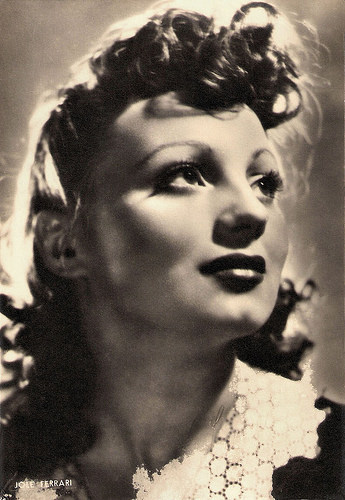
Italian postcard by ASER, no. 152. Photo: Luxardo.

Italian postcard by Rotante, no. 0024. Photo: Luxardo.
Princess Clementina
Her final film role was as the principessa Clementina in the historical drama film Luisa Sanfelice (Leo Menardi, 1942) featuring Laura Solari and also starring Massimo Serato and Osvaldo Valenti.
The film is an adaptation of a novel by Alexandre Dumas based on the story of Luisa Sanfelice (1764-1800) an Italian aristocrat executed in Naples by Ferdinand I for supporting a Republican attempt to overthrow him during the French Revolutionary Wars.
Luisa Sanfelice was made at the Cinecittà Studios in Rome. One of the film's screenwriters was Vittorio Mussolini, the son of dictator Benito Mussolini, who was heavily involved in the Italian film industry.
We could not find more about Jole Ferrari at the net. If you have more information, please let us know.

Andrea Checchi . Italian postcard by ASER (A. Scararamaglia Edizioni Roma).

Massimo Girotti . Italian postcard by ASER (A. Scaramaglia Ed. Roma), no. 223. Photo: Ciolfi.
Sources: Gerald A. De Luca (IMDb), Wikipedia and .

Italian postcard by ASER, no. 147. Photo: Luxardo.
Robin Hood, Neapolitan Style
In 1939, Jole Ferrari started her film career with a small part in the Swashbuckler Un' avventura di Salvator Rosa/An Adventure of Salvator Rosa (Alessandro Blasetti, 1939) starring Gino Cervi and Luise Ferida .
Gerald A. De Luca at IMDb : "Salvatore Rosa was a versatile poet and painter of landscapes and battles. His romantic life is the inspiration for this fictional tale of the masked hero, 'The Ant', Rosa's alter-ego, a friend and defender of the poor citizens of the Naples area who are oppressed by the evil viceroy. This is "Robin Hood, Neapolitan Style", and great fun."
Ferrari had another small part in Ricchezza senza domain/Wealth and no tomorrow (Ferdinando Maria Poggioli, 1940) with Lamberto Picasso, Paola Borboni and Doris Duranti .
She had a big supporting part in I pirati del golfo/Pirates of the Bay (Romolo Marcellini, 1940) opposite Andrea Checchi .
She had more supporting parts in L'elisir d'amore/The Elixir of Love (Amleto Palermi, 1941), based on the comic opera by Gaetano Donizetti, and in La famiglia Brambilla in vacanza/Brambilla family on vacation (Carl Boese, 1941) with dreamboat Massimo Girotti .

Italian postcard by ASER, no. 152. Photo: Luxardo.

Italian postcard by Rotante, no. 0024. Photo: Luxardo.
Princess Clementina
Her final film role was as the principessa Clementina in the historical drama film Luisa Sanfelice (Leo Menardi, 1942) featuring Laura Solari and also starring Massimo Serato and Osvaldo Valenti.
The film is an adaptation of a novel by Alexandre Dumas based on the story of Luisa Sanfelice (1764-1800) an Italian aristocrat executed in Naples by Ferdinand I for supporting a Republican attempt to overthrow him during the French Revolutionary Wars.
Luisa Sanfelice was made at the Cinecittà Studios in Rome. One of the film's screenwriters was Vittorio Mussolini, the son of dictator Benito Mussolini, who was heavily involved in the Italian film industry.
We could not find more about Jole Ferrari at the net. If you have more information, please let us know.

Andrea Checchi . Italian postcard by ASER (A. Scararamaglia Edizioni Roma).

Massimo Girotti . Italian postcard by ASER (A. Scaramaglia Ed. Roma), no. 223. Photo: Ciolfi.
Sources: Gerald A. De Luca (IMDb), Wikipedia and .
Published on March 23, 2015 23:00
Paul van Yperen's Blog
- Paul van Yperen's profile
- 13 followers
Paul van Yperen isn't a Goodreads Author
(yet),
but they
do have a blog,
so here are some recent posts imported from
their feed.



